商品详情
返回产品目录商品包装及说明书因厂家更换频繁,如有不符以实物为主
阿培利司片
国际零售参考价:¥**/盒
产品参数 中文说明 外文说明关联产品 本品资讯
-
- 通用名称
- 阿培利司片
- 商品名
- Pivikto
- 其它名称
- 阿博利布、阿尔派西伯、阿培利斯、阿尔贝利斯、阿尔卑利昔、阿哌利西、阿吡利塞、QCR-1、BYL-719、NVP-BYL-719
- 英文名称
- Alpelisib
- 包装规格
- 150mg×28片
- 关键词
- 乳腺癌
- 产地及厂家
- 瑞士诺华印度(Novartis)
- 适应症范围
- 在治疗更年期后妇女和男性时,与激素受体(HR2)阳性、人表皮生长因子受体2(HER2)阴性、Pik3Ca突变、晚期或转移性乳腺癌联合应用药物管理局核准的测试,在内分泌治疗方案进行或之后检测。
- 其它说明
- 可以预定
- 靶点
- PI3K激酶抑制剂、PIK3CA
-
温馨提醒:本说明书仅供参考,最新的说明书详见药品附带的说明书。
完整的处方信息
1适应症和用途
PIQRAY与氟维司群合用,用于治疗绝经后的女性和男性,荷尔蒙受体(HR)阳性,人表皮生长因子受体2(HER2)阴性,PIK3CA突变,晚期或转移性乳腺癌的检测方法为内分泌治疗方案进展后或之后,经过FDA批准的测试。
2用法用量
2.1患者选择
根据肿瘤组织或血浆样本中存在一种或多种PIK3CA突变,选择使用PIQRAY治疗HR阳性,HER2阴性的晚期或转移性乳腺癌的患者[参见临床研究(14)]。如果在血浆标本中未检测到突变,请测试肿瘤组织。有关FDA批准的用于检测乳腺癌中PIK3CA突变的测试的信息,请访问:http : //www.fda.gov/CompanionDiagnostics。
2.2剂量和给药
PIQRAY的推荐剂量为300毫克(两片150毫克薄膜衣片),每天一次,与食物一起口服[见临床药理学(12.3)]。
继续治疗直至疾病进展或出现不可接受的毒性[参见剂量和用法(2.3)]。
患者应每天大约在同一时间服用PIQRAY。
吞咽整粒PIQRAY片剂(吞咽前不得咀嚼,压碎或分裂片剂)。如果片剂破裂,破裂或不完整,则不得摄入片剂。
如果错过了一定剂量的PIQRAY,可以在通常服用时间后的9小时内与食物一起服用。9个多小时后,跳过当天的剂量。第二天,在通常的时间服用PIQRAY。
如果患者在服药后呕吐,建议患者当天不要再服药,并在第二天的正常时间恢复用药时间表。
当与PIQRAY一起使用时,氟维司群的推荐剂量为在第1、15和29天服用500毫克,此后每月一次。有关氟维司群的信息,请参阅“完整处方信息”。
2.3不良反应的剂量修改
表1列出了建议的不良反应(ARs)剂量调整方案。
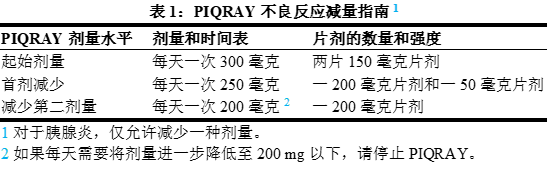
表2、3、4和5总结了在特定AR治疗中PIQRAY的剂量中断,减少或中断的建议。
高血糖症
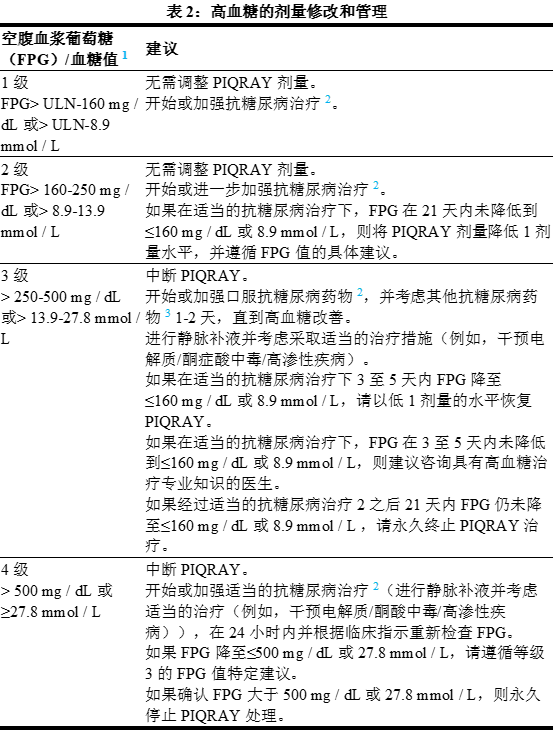
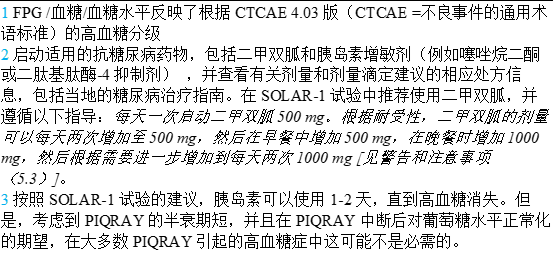
皮疹
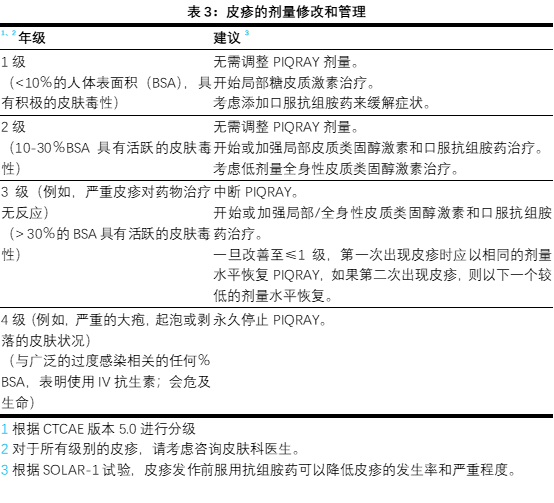
腹泻
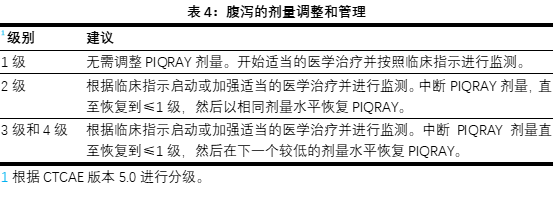
其他毒性
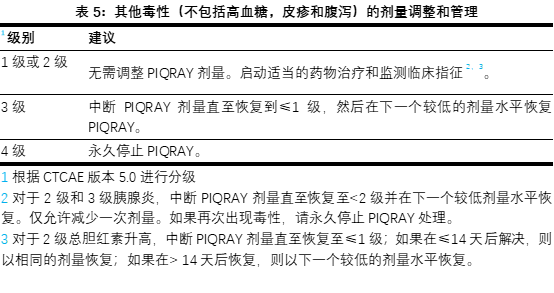
有关毒性的剂量调整指南和其他相关的安全信息,请参阅氟维司群的完整处方信息。
3剂型和强度
片剂:50 mg,150 mg和200 mg alpelisib
50 mg:浅粉红色,未刻划,圆形,弯曲,带有斜边薄膜衣片,一侧印有“ L7”,另一侧印有“ NVR”。
150 mg:浅红色,无痕,椭圆形,弯曲,带有斜边薄膜衣片,一侧印有“ UL7”,另一侧印有“ NVR”。
200毫克:浅红色,未刻划,椭圆形,弯曲,带有斜边薄膜衣片,一侧印有“ YL7”,另一侧印有“ NVR”。
4禁忌症
PIQRAY是对它或其任何成分有严重超敏反应的患者的禁忌症[参见警告和注意事项(5.1)]。
5警告和注意事项
5.1严重超敏反应
PIQRAY治疗的患者发生了严重的超敏反应,包括过敏反应和过敏性休克。严重的超敏反应表现为症状,包括但不限于呼吸困难,潮红,皮疹,发烧或心动过速。
3级和4级超敏反应的发生率为0.7%[请参阅不良反应(6)]。
告知患者严重的超敏反应的体征和症状。如果出现严重超敏反应,请永久停止使用PIQRAY。
5.2严重的皮肤反应
据报道,接受PIQRAY 治疗的患者出现了严重的皮肤反应,包括史蒂文斯-约翰逊综合症(SJS)和多形红斑(EM)[见不良反应(6)]。
据报道分别有0.4%和1.1%的患者患有SJS和EM。有SJS,EM或有毒表皮坏死(TEN)病史的患者请勿开始PIQRAY治疗。
如果发生严重皮肤反应的体征或症状,请中断PIQRAY直至确定反应的病因。建议咨询皮肤科医生。
如果确认了SJS,TEN或EM,请永久中断PIQRAY。对于在PIQRAY治疗期间曾经历过严重皮肤反应的患者,请勿重新使用PIQRAY。
如果未确认SJS,TEN或EM,则PIQRAY可能需要调整剂量,局部应用糖皮质激素或口服抗组胺药,如表3所述[请参见剂量和用法(2.3)]。
告知患者严重的皮肤反应的体征和症状(例如发烧的前兆,流感样症状,粘膜病变或进行性皮疹)。
5.3高血糖
在用PIQRAY治疗的患者中已报道了严重的高血糖症,包括酮症酸中毒。据报道,接受PIQRAY治疗的患者中有65%患有高血糖症。据报道分别有33%和3.9%的患者发生3级(FPG> 250-500 mg / dL)和4级(FPG> 500 mg / dL)高血糖。接受PIQRAY治疗的患者中有0.7%(n = 2)发生酮症酸中毒。
在经历≥2级(FPG 160-250 mg / dL)高血糖的患者中,首次发生高血糖的中位时间为15天(范围:5至517天)。
在187例高血糖患者中,有87%(163/187)用抗糖尿病药物治疗,而76%(142/187)报告称使用二甲双胍作为单一药物或与其他抗糖尿病药物[即胰岛素]联用,二肽基肽酶-4(DPP-4)抑制剂和磺酰脲类药物]。对于≥2级高血糖且至少改善1级的患者(n = 153),自首次事件开始改善的中位时间为8天(范围:2至65天)。
在中断PIQRAY后继续进行氟维司群治疗的FPG升高的所有患者中(n = 54),有96%(n = 52)的患者的FPG水平恢复到基线水平。
在开始使用PIQRAY治疗之前,测试FPG,HbA1c并优化血糖。在开始使用PIQRAY进行治疗后,应在头2周内每周至少监测一次血糖和/或FPG,然后每4周至少监测一次,并按照临床指示进行。每3个月并根据临床指示监测HbA1c。
如果患者在开始使用PIQRAY治疗后出现高血糖症,请按照临床指示监测血糖和/或FPG,每周至少两次,直到血糖或FPG降至正常水平。在使用抗糖尿病药物治疗期间,应至少每周连续监测血糖或FPG,持续8周,然后每2周监测一次,并根据临床指示进行。考虑咨询具有高血糖治疗专业知识的医疗保健从业者,并就生活方式的改变向患者提供咨询。
尚未确定PIQRAY在1型和2型糖尿病不受控制的患者中的安全性,因为这些患者被排除在SOLAR-1试验之外。包括有2型糖尿病病史的患者。有糖尿病病史的患者可能需要强化糖尿病治疗。密切监测糖尿病患者。
根据高血糖的严重程度,PIQRAY可能需要中断,减少或中断剂量,如表2所述[请参见剂量和用法(2.3)]。
告知患者高血糖的体征和症状(例如,口渴,比平时排尿更多或尿量比平时多,或食欲增加且体重减轻)。
5.4肺炎
在用PIQRAY治疗的患者中已报道了严重的肺炎,包括急性间质性肺炎和间质性肺疾病。
据报道,接受PIQRAY治疗的患者中有1.8%患有肺炎。
对于出现新的或恶化的呼吸道症状或怀疑患有肺炎的患者,应立即中断PIQRAY并评估患者的肺炎。考虑在放射学检查中表现出具有非特异性呼吸道症状和体征(例如低氧,咳嗽,呼吸困难或间质浸润)的患者的非感染性肺炎的诊断,并且已通过适当方法排除了感染性,肿瘤性和其他原因调查。
在所有确诊为肺炎的患者中永久停用PIQRAY。
劝告患者立即报告新的或恶化的呼吸道症状。
5.5腹泻
PIQRAY治疗的患者发生了严重的腹泻,包括脱水和急性肾损伤。大多数患者(58%)在用PIQRAY治疗期间出现腹泻。7%(n = 19)的患者发生3级腹泻。在2级或3级腹泻患者(n = 71)中,发病的中位时间为46天(范围:1至442天)。
6%的患者需要减少PIQRAY的剂量,而由于腹泻而永久停用PIQRAY的患者需要降低2.8%的剂量。在164位经历腹泻的患者中,有63%(104/164)的患者需要使用抗腹泻药(例如洛哌丁胺)来缓解症状。
根据腹泻的严重程度,PIQRAY可能需要中断,减少或中断剂量,如表4所述[参见剂量和用法(2.3)]。
建议患者开始止泻治疗,增加口服液,如果在服用PIQRAY时出现腹泻,请通知其医疗保健提供者。
5.6胚胎-胎儿毒性
根据动物中的发现及其作用机理,PIQRAY对孕妇给药可引起胎儿伤害。在动物生殖研究中,在器官发生过程中对怀孕的大鼠和兔子口服alpelisib会导致不良的发育结果,包括胚胎-胎儿死亡率(植入后损失),胎儿体重减少以及基于母体暴露面积的胎儿母体畸形发生率增加。推荐剂量为300毫克/天时人体暴露量的≥0.8倍的曲线(AUC)。建议孕妇和具有生殖潜力的女性对胎儿的潜在危险。建议有生殖潜力的女性在使用PIQRAY治疗期间使用有效的避孕方法最后一剂后1周。建议具有生殖潜力的女性伴侣的男性患者在PIQRAY治疗期间以及最后一次给药后1周内使用安全套和有效的避孕方法(请参见“在特定人群中使用(8.1、8.3 )和临床药理学(12.1)”)。
有关妊娠和避孕的信息,请参阅氟维司群的完整处方信息。
6不良反应
标签的其他部分将详细讨论以下不良反应:
- 严重超敏反应[请参阅警告和注意事项(5.1)]
- 严重的皮肤反应[请参阅警告和注意事项(5.2)]
- 高血糖[请参阅警告和注意事项(5.3)]
- 肺炎[见警告和注意事项(5.4)]
- 腹泻[见警告和注意事项(5.5)]
6.1临床试验经验
由于临床试验是在广泛不同的条件下进行的,因此无法将在某种药物的临床试验中观察到的不良反应率直接与另一种药物的临床试验中观察到的不良反应率进行比较,并且可能无法反映实际中观察到的不良反应率。
PIQRAY的安全性在一项随机,双盲,安慰剂对照试验(SOLAR-1)中评估了571名HR阳性,HER2阴性,晚期或转移性乳腺癌患者,分为两组,有或没有PIK3CA突变[见临床研究(14)]。
患者接受PIQRAY 300 mg加氟维司群(n = 284)或安慰剂加氟维司群(n = 287)。在治疗阶段的每个28天周期的第1周期第1天和第15天,然后在第1天肌注500份Fulvestrant 500 mg。
接受PIQRAY加氟维司群治疗的2例患者(0.7%)死于根本性恶性肿瘤以外的其他原因。死亡原因包括一例心脏呼吸骤停和一例原发性恶性肿瘤。两者均未怀疑与研究治疗有关。
接受PIQRAY加氟维司群的患者中有35%发生了严重的不良反应。在接受PIQRAY加氟维司群治疗的患者中,> 2%的严重不良反应包括高血糖(10%),皮疹(3.5%),腹泻(2.8%),急性肾损伤(2.5%),腹痛(2.1%)和贫血( 2.1%)。
在PIQRAY加氟维司群组中,有4.2%(12/284)的患者发生颌骨坏死(ONJ),而在安慰剂组中为1.4%(4/287)的患者。所有经历过ONJ的患者都曾接受过或同时服用双膦酸盐或RANK-配体抑制剂。
在接受PIQRAY加氟维司群的患者中,由于ARs ,4.6%的患者永久停用PIQRAY和氟维司群,而21%的患者永久停用PIQRAY。接受PIQRAY加氟维司群治疗的> 2%的患者中导致PIQRAY治疗中断的最常见AR 是高血糖(6%),皮疹(4.2%),腹泻(2.8%)和疲劳(2.5%)。
55%接受PIQRAY加氟维司群的患者因AR引起的剂量减少。接受PIQRAY加氟维司群治疗的> 2%患者中最常见的导致减少剂量的AR 是高血糖(29%),皮疹(9%),腹泻(6%),口腔炎(3.5%)和粘膜炎症(2.1%)。
最常见的不良反应包括实验室异常(所有级别,发生率≥20%)是葡萄糖升高,肌酐升高,腹泻,皮疹,淋巴细胞计数降低,GGT升高,恶心,ALT升高,疲劳,血红蛋白降低,脂肪酶升高,食欲下降,口腔炎,呕吐,体重减轻,钙减少,葡萄糖减少,aPTT延长和脱发。
不良反应和实验室异常分别列于表6和表7中。
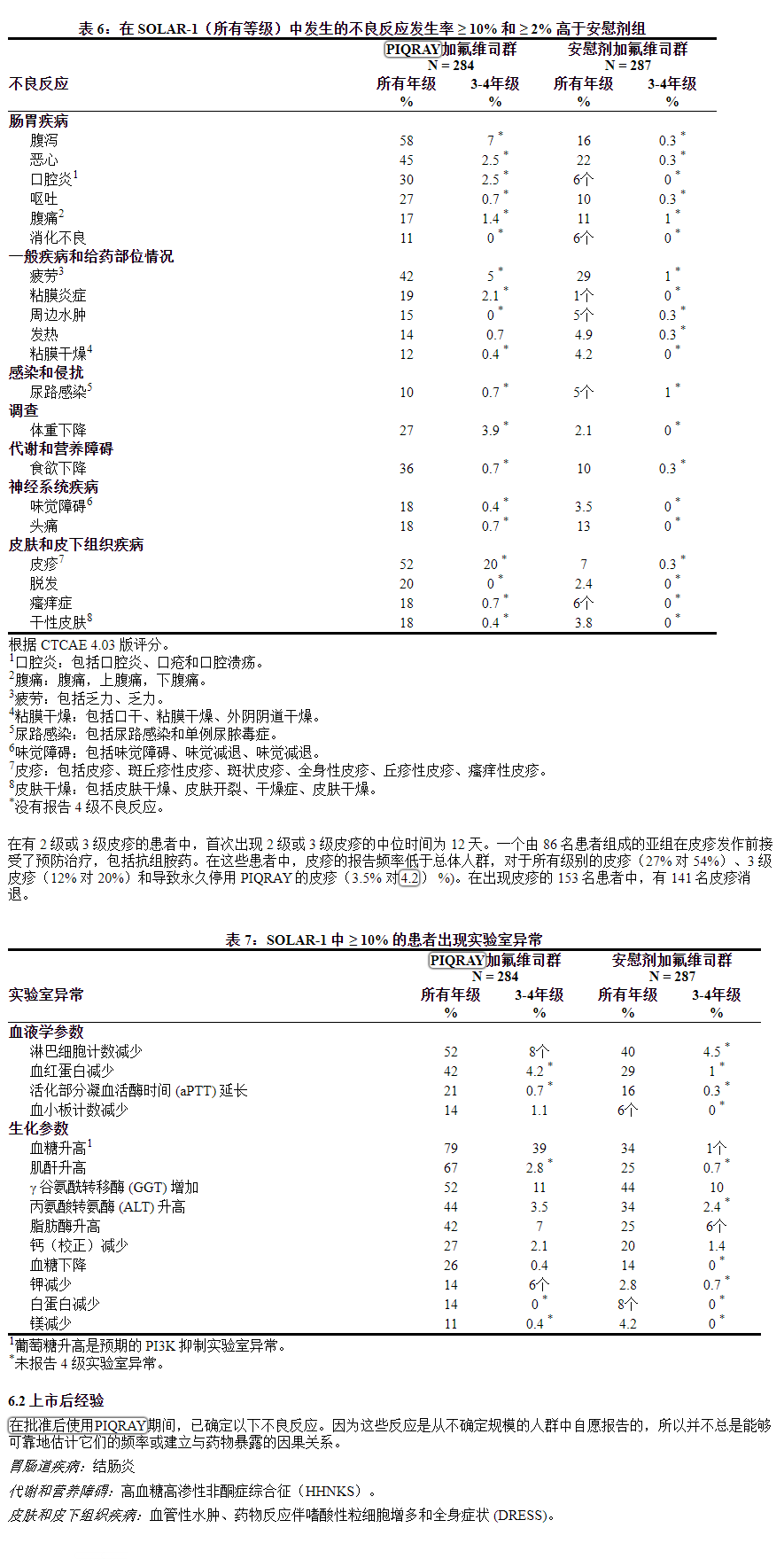
7药物相互作用
7.1其他药物对PIQRAY的影响
CYP3A4诱导剂
PIQRAY与强效CYP3A4诱导剂的共同给药可能降低alpelisib的浓度[见临床药理学(12.3)],可能会降低alpelisib的活性。避免PIQRAY与强效CYP3A4诱导剂共同给药。
BCRP抑制剂
合用PIQRAY与BCRP抑制剂可以增加alpelisib浓度[见临床药理学(12.3)],这可以增加毒性的风险。PIQRAY治疗的患者应避免使用BCRP抑制剂。如果无法使用替代药物,当PIQRAY与BCRP抑制剂组合使用时,应密切监测不良反应的增加。
7.2 PIQRAY对其他药物的影响
CYP2C9底物
PIQRAY与CYP2C9底物(例如华法林)的共同给药可能降低这些药物的血浆浓度[见临床药理学(12.3)]。密切监视PIQRAY与CYP2C9底物组合使用的情况,其中CYP2C9底物的血浆浓度降低可能会降低这些药物的活性。
8在特定人群中的使用
8.1怀孕
风险摘要
PIQRAY与氟维司群合用。有关怀孕的信息,请参阅氟维司群的完整处方信息。
根据动物数据和作用机理,PIQRAY对孕妇给药可引起胎儿伤害[见临床药理学(12.1)]。孕妇没有可用的数据来告知与药物相关的风险。在动物生殖研究中,在器官发生过程中对怀孕的大鼠和兔子口服alpelisib会导致不良的发育结果,包括胚胎-胎儿死亡率(植入后损失),胎儿体重减少以及母体暴露≥0.8倍时胎儿畸形的发生率增加根据AUC在人体中的建议剂量为300毫克/天(参见数据)。建议孕妇和具有生殖潜力的女性对胎儿的潜在危险。
对于指定人群,估计的主要先天缺陷和流产的背景风险尚不清楚。但是,在美国一般人群中,估计的主要先天缺陷的背景风险为临床公认的妊娠的2%至4%,流产为15%至20%。
数据
动物资料
在大鼠和兔子的胚胎-胎儿发育研究中,怀孕的动物在器官发生期间接受了口服剂量的alpelisib,最高剂量为30 mg / kg /天。
在大鼠中,口服alpelisib会导致母体毒性(体重减轻,食物消耗减少),并且在30 mg / kg / day的剂量下(约3倍于人体暴露量的人体),无存活胎儿(植入后损失)。 300毫克/天(基于AUC)。剂量为10 mg / kg /天(约为AUC建议剂量300 mg /天,人体暴露量的0.8倍,基于AUC),其毒性包括胎儿体重减轻和骨骼畸形(弯曲的肩骨以及增厚或弯曲)的发生率增加长骨头)和胎儿变异(脑室增大,骨骨化降低)。
在一项针对兔子的胚胎胚胎发育试验中,每天30 mg / kg的剂量不会导致胎儿存活(植入后损失)。≥15 mg / kg / day的剂量导致胚胎-胎儿死亡增加,胎儿重量减少和畸形,这主要与尾巴和头部有关。在兔子中,母体暴露量为15 mg / kg / day时,基于AUC,建议的人类剂量为300 mg / day时,母体暴露量约为暴露量的5倍。
8.2哺乳
PIQRAY与氟维司群合用。有关泌乳的信息,请参阅氟维司群的完整处方信息。
没有关于母乳中alpelisib的存在,其对产奶量或母乳喂养孩子的影响的数据。由于母乳喂养的孩子可能会出现严重的不良反应,因此建议哺乳期妇女在PIQRAY治疗期间以及最后一次给药后1周内不要母乳喂养。
8.3生殖潜力的男性和女性
PIQRAY与氟维司群合用。有关避孕和不育的信息,请参阅氟维司群的完整处方信息。
验孕
在开始PIQRAY之前,请验证具有生殖潜力的女性的怀孕状况。
避孕
女性
给孕妇服用PIQRAY可能会造成胎儿伤害[请参见“在特定人群中使用(8.1)”)。劝告有生殖潜力的女性在用PIQRAY治疗期间以及最后一次给药后1周内使用有效的避孕方法。
雄性
建议有生殖潜力的女性伴侣的男性患者在用PIQRAY治疗期间以及末次给药后1周内使用避孕套和有效避孕方法。
不孕症
根据动物研究的结果,PIQRAY可能会损害雄性和雌性生殖能力的繁殖力[请参阅非临床毒理学(13.1)]。
8.4小儿使用
尚未确定PIQRAY在儿科患者中的安全性和有效性。
8.5老年人使用
在SOLAR-1试验中284名接受PIQRAY的患者中,≥65岁的患者为117名,≥75岁的患者为34名。在接受PIQRAY加氟维司群治疗的患者中,≥65岁的患者(44%)的3-4级高血糖发生率高于<65岁的患者(32%)。与年轻患者相比,≥65岁的患者之间未观察到PIQRAY有效性的总体差异。≥75岁的患者数量不足以评估安全性或有效性是否存在差异。
8.6肾功能不全
严重肾功能不全(CLcr <30 mL / min)对alpelisib药代动力学的影响尚不清楚[见临床药理学(12.3)]。
对于轻度至中度肾功能不全(CLcr 30至<90 mL / min)的患者,建议不调整剂量。
10过量
在临床试验中,过量服用PIQRAY的经验有限。在临床研究中,PIQRAY的每日剂量最高为450 mg。
在临床研究中报告意外过量服用PIQRAY的情况下,与过量服用有关的不良反应与PIQRAY已知的安全性相一致,包括高血糖,恶心,虚弱和皮疹。
如有必要,在所有用药过量的情况下,采取一般的对症和支持措施。没有PIQRAY的解毒剂。
11说明
PIQRAY(alpelisib)是一种激酶抑制剂。alpelisib的化学名称为(2 S)-N 1- [4-甲基-5- [2-(2,2,2-三氟-1,1-二甲基乙基)-4-吡啶基] -2-噻唑基]- 1,2-吡咯烷二甲酰胺。Alpelisib是白色至几乎白色的粉末。alpelisib的分子式为C 19 H 22 F 3 N 5 O 2 S,相对分子质量为441.47 g / mol。alpelisib的化学结构如下所示:
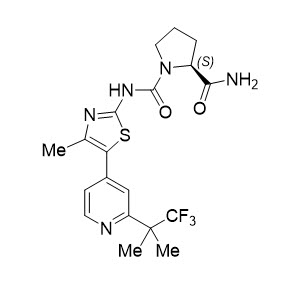
PIQRAY薄膜包衣片剂用于口服给药,三种强度分别含有50 mg,150 mg和200 mg alpelisib。片剂还含有羟丙甲纤维素,硬脂酸镁,甘露醇,微晶纤维素和羟乙酸淀粉钠。薄膜包衣含有羟丙甲纤维素,氧化铁黑,氧化铁红,聚乙二醇/聚乙二醇(PEG)4000,滑石粉和二氧化钛。
12临床药理学
12.1行动机制
Alpelisib是磷脂酰肌醇3-激酶(PI3K)的抑制剂,主要具有针对PI3Kα的抑制活性。在体外和体内模型中,编码PI3K催化性α-亚基(PIK3CA)的基因中的功能获得性突变导致PI3Kα激活和Akt信号转导,细胞转化以及肿瘤的产生。
在乳腺癌细胞系中,alpelisib抑制PI3K下游靶标(包括Akt)的磷酸化,并在具有PIK3CA突变的细胞系中显示活性。在体内,alpelisib在异种移植模型(包括乳腺癌模型)中抑制PI3K / Akt信号传导途径并降低肿瘤生长。
通过alpelisib治疗抑制PI3K已显示可诱导乳腺癌细胞中雌激素受体(ER)转录增加。与单独的两种治疗方法相比,alpelisib和fulvestrant的组合具有增强的抗肿瘤活性,而这两种方法均来自ER阳性,PIK3CA突变的乳腺癌细胞系。
12.2药效学
心脏电生理学
单剂量后在稳态下收集连续ECG,以评估alpelisib对晚期癌症患者QTcF间隔的影响。对临床ECG数据的分析表明,在推荐的300 mg剂量(含或不含氟司韦汀)下,对QTcF延长没有明显影响(即> 20 ms)。
12.3药代动力学
已经在健康受试者和患有实体瘤的成年患者中研究了alpelisib的药代动力学。在进食条件下,稳态alpelisib最高血浆浓度(C max)和AUC在30 mg至450 mg(批准推荐剂量的0.1至1.5倍)的剂量范围内成比例增加。alpelisib的平均蓄积量为1.3至1.5,每日剂量后3天内达到稳态血浆浓度。在SOLAR-1试验中每天接受一次PIQRAY 300 mg的成年患者中,人群方法得出的C max的平均稳态alpelisib [变异系数(CV%)]为2480(23%)ng / mL,AUC 0- 24hr为33224(21%)ng * h / mL。
吸收性
达到血浆峰值浓度(T max)的中值时间为2.0到4.0小时。
食物的作用
的高脂肪高热量膳食(985个卡路里58.1克的脂肪)增加的alpelisib AUC 73%和C 最大 84%,和低脂肪低热量的膳食(334个卡路里8.7克脂肪)增加的alpelisib 单次注射PIQRAY后, AUC降低了77%,Cmax降低了145%。低脂低热量和高脂高热量饮食之间未观察到alpelisib AUC的临床显着差异。
分配
稳定状态下alpelisib的平均表观分布体积(%CV)预计为114 L(46%)。alpelisib的蛋白质结合率为89%,与浓度无关。
消除
alpelisib的半衰期预计为8到9小时。在进食条件下,alpelisib的平均清除率(%CV)预计为9.2 L / hr(21%)。
代谢
Alpelisib主要在体外通过化学和酶水解作用代谢形成其代谢产物BZG791,在较小程度上被CYP3A4代谢。
排泄
在禁食的情况下单次口服400 mg放射性标记的alpelisib,粪便中回收的剂量为81%(36%不变,BZG791为32%)和14%(2%不变,7.1%BZG791)。CYP3A4介导的代谢产物(12%)和葡糖醛酸苷约占剂量的15%。
特定人群
根据年龄(21至87岁),性别,种族/民族(日本或高加索人),体重(37至181 kg),轻至中度肾功能不全(CLcr为30至30),未预测alpelisib药代动力学的临床显着差异。根据Cockcroft-Gault公式,<90 mL / min,或轻度至重度肝功能不全(Child-Pugh A,B和C级)。严重肾功能不全(CLcr <30 mL / min)对alpelisib药代动力学的影响尚不清楚。
药物相互作用研究
临床研究
减酸剂: PIQRAY可与减酸剂共同使用,因为PIQRAY应与食物一起服用。食物对alpelisib的溶解度比胃pH值的影响更明显。
H 2受体拮抗剂雷尼替丁与300 mg口服单剂量的alpelisib并用会降低alpelisib的吸收和总体暴露。在低脂肪低热量膳食的存在下,AUC为平均降低了21%和C 最大雷尼替丁36%。下禁食状态,AUC进行平均降低了30%和C 最大雷尼替丁51%。
CYP3A4底物:与alpelisib并用时,依维莫司(CYP3A4和P-gp的底物)的药代动力学在临床上无显着差异。
体外研究
Alpelisib对CYP酶的影响: Alpelisib以时间依赖性方式抑制CYP3A4并诱导CYP2B6,CYP2C9和CYP3A4。
转运蛋白对Alpelisib的影响: Alpelisib是BCRP的底物。
Alpelisib对转运蛋白的影响: Alpelisib是P-gp的抑制剂。Alpelisib在临床相关浓度下具有抑制BCRP,MRP2,BSEP,OATP1B1,OATP1B3,OCT1,OAT1,OAT3,OCT2,MATE1和MATE2K的低潜力。
13毒理学
13.1致癌,诱变,生育力受损
尚未对alpelisib进行致癌性研究。
Alpelisib在体外细菌反向突变(Ames)分析中没有致突变性,在人细胞微核和染色体畸变测试中不具有致突变性或致裂性。在体内大鼠微核试验中,Alpelisib没有遗传毒性。
尚未对动物进行生育力研究。在长达13周的重复剂量毒性研究中,在≥6 mg / kg / day的剂量下,大鼠生殖器官出现不良反应,包括阴道萎缩和发情周期变化(约为推荐剂量的人类暴露量的0.6倍)。 ≥15 mg / kg /天的剂量(按AUC每天300毫克/天)和狗的前列腺萎缩(约为300毫克/天的推荐剂量人的暴露量的2.6倍)。
14临床研究
SOLAR-1(NCT02437318)是PIQRAY加氟维司群与安慰剂加氟维司群的一项随机,双盲,安慰剂对照试验,用于572 HR阳性,HER2阴性,晚期或转移性乳腺癌患者,病情已于此后复发或复发或在基于芳香酶抑制剂的处理后(有或没有CDK4 / 6组合)。如果患者患有炎症性乳腺癌,1型糖尿病或不受控制的2型或肺炎,则排除在外。根据肺和/或肝转移的存在以及先前用CDK4 / 6抑制剂的治疗进行分层。总体而言,入组患者中有60%的肿瘤组织中存在一种或多种PIK3CA突变,有50%的患者患有肝/肺转移,有6%的患者此前曾用CDK4 / 6抑制剂治疗。
在该队列中,有341例患者的肿瘤组织有PIK3CA突变,而在没有PIK3CA突变的队列中有231名患者。在341例患者中有PIK3CA基因突变的人群中,有336(99%)患者有一个或多个PIK3CA突变使用FDA批准的证实肿瘤组织中therascreen ® PIK3CA RGQ PCR试剂盒。出了336例PIK3CA基因突变的肿瘤组织中证实,19名患者没有可用来与美国FDA批准的测试的血浆标本therascreen ® PIK3CA RGQ PCR试剂盒。在肿瘤组织中确认的其余317名PIK3CA突变患者中,有177名患者(56%)在血浆样本中发现了PIK3CA突变,而140名患者(44%)在血浆样本中未发现PIK3CA突变。
患者每天连续一次口服PIQRAY(300 mg)或安慰剂,在第1周期的第1天,第15天和第15天,然后在每28天的周期的第1天,肌内注射氟维司群(500 mg)。患者接受治疗,直至影像学疾病进展或出现不可接受的毒性。在最初的18个月中每8周进行一次肿瘤评估,此后每12周进行一次肿瘤评估。
患者的中位年龄为63岁(范围为25至92)。大多数患者为女性(99.8%),大多数患者为白人(66%),其次是亚裔(22%),其他/未知(10%),黑人或非裔美国人(1.4%)以及美洲印第安人或阿拉斯加土著( 0.9%)。基线ECOG绩效状态为0(68%)或1(32%)。
具有PIK3CA突变肿瘤的患者的人口统计学资料通常是更广泛研究人群的代表。PIQRAY加氟维司群的中位暴露时间为8.2个月,其中59%的患者暴露时间超过6个月。
大多数患者(98%)接受过激素治疗作为最后的治疗方法(48%为转移性环境,52%为辅助性环境)。在13%的患者中观察到原发性内分泌耐药性(定义为辅助内分泌治疗在24个月内复发或在晚期疾病的内分泌治疗6个月内进展),继发内分泌耐药性(定义为在辅助内分泌治疗24个月后复发)在72%的患者中观察到辅助内分泌治疗结束后12个月内,或在晚期疾病的内分泌治疗后6个月内进展。
主要疗效结果是根据实体瘤反应评估标准(RECIST)v1.1在队列中进行PIK3CA突变的研究者评估的无进展生存期(PFS)。其他疗效结果指标是具有PIK3CA突变的人群的总体缓解率(ORR)和总体生存率(OS)。
表8和图1给出了肿瘤组织中具有PIK3CA突变的队列的疗效结果。独立调查委员会(BIRC)评估的一致结果支持了研究者评估的具有PIK3CA突变的队列的PFS结果。在具有组织或血浆PIK3CA突变的患者中观察到一致的结果。在进行最终PFS分析时,有27%(92/341)的患者死亡,并且总体生存随访还不成熟。
在没有PIK3CA组织突变的肿瘤患者中未观察到PFS获益(HR = 0.85; 95%CI:0.58,1.25)。
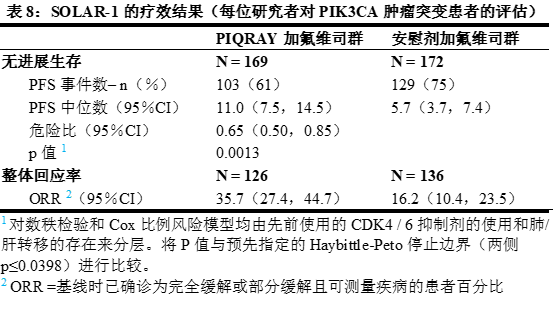
图1:SOLAR-1中的无进展生存期(每位研究者对PIK3CA肿瘤突变患者的评估)
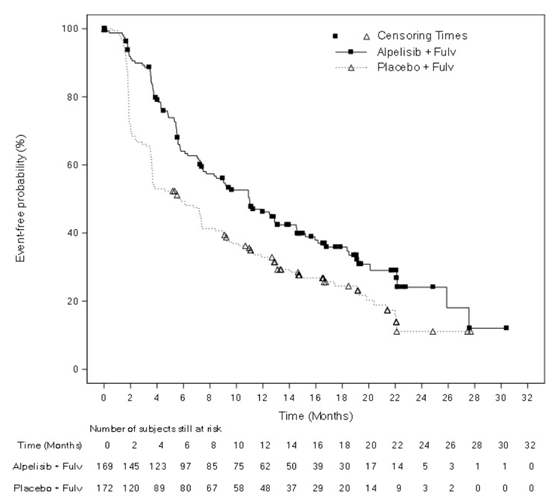
16供应/存储和处理方式
PIQRAY(alpelisib)50 mg,150 mg和200 mg薄膜衣片[请参阅剂型和剂量(3)]。
每日300毫克剂量:每个纸箱包含2个泡罩包装。每个泡罩包装包含14天内供应的28片药片(28片药片,每片150毫克alpelisib)。NDC 0078-0708-02
每日250毫克剂量:每个纸箱包含2个泡罩包装。每个泡罩包装包含14天内的28片药片(14片,每片200 mg alpelisib和14片,每片50 mg alpelisib)。NDC 0078-0715-02
每日200毫克剂量:每个纸箱包含1个泡罩包装。每个泡罩包装包含28片28天的药量(28片,每片200毫克alpelisib)。NDC 0078-0701-84
存放在20°C至25°C(68°F至77°F),允许偏移在15°C至30°C(59°F至86°F)之间[请参阅USP控制的室温]。
17患者咨询信息
建议患者阅读FDA批准的患者标签(患者信息)。
严重超敏反应
告知患者过敏的体征和症状。建议患者立即联系其医疗保健提供者以了解超敏反应的体征和症状[参见警告和注意事项(5.1)]。
严重皮肤反应
告知患者严重的皮肤反应的体征和症状。劝告患者立即联系其医疗保健提供者,以了解严重的皮肤反应的体征和症状[见警告和注意事项(5.2)]。
高血糖症
建议患者在治疗过程中可能出现高血糖症,并需要定期监测血糖。建议患者立即联系其医疗保健提供者以了解高血糖的体征和症状[见警告和注意事项(5.3)]。
肺炎
告知患者发生肺炎的可能性,如果他们遇到呼吸系统问题,请立即与他们的医护人员联系[请参阅警告和注意事项(5.4)]。
腹泻
告知患者PIQRAY可能引起腹泻,在某些情况下可能会很严重。告知患者开始止泻治疗,增加口服液,如果在服用PIQRAY 时出现腹泻,请通知其医疗保健提供者[请参阅警告和注意事项(5.5)]。
胚胎-胎儿毒性
- 告知孕妇和生殖能力胎儿的潜在风险。劝告女性告知其已知或怀疑怀孕的医疗人员[请参阅警告和注意事项(5.6)和在特定人群中使用(8.1)]。
- 劝告有生殖潜力的女性在用PIQRAY治疗期间以及最后一次用药后1周内使用有效的避孕方法[请参见在特定人群中使用(8.3)]。
- 建议具有生殖潜力的女性伴侣的男性患者在PIQRAY治疗期间以及最后一剂后1周使用安全套和有效避孕措施(请参见“在特定人群中使用(8.3)”)。
- 有关妊娠和避孕的信息,请参阅氟维司群的完整处方信息。
哺乳期
劝告妇女在用PIQRAY治疗期间以及最后一次给药后1周内不要母乳喂养[见在特定人群中使用(8.2)]。有关泌乳的信息,请参阅氟维司群的完整处方信息。
不孕症
向有生殖潜力的男性和女性建议PIQRAY可能会损害生育能力[请参见在特定人群中使用(8.3)]。有关不育的信息,请参阅氟维司群的完整处方信息。
药物相互作用
劝告患者在PIQRAY治疗的患者中避免使用强CYP3A4诱导剂。建议患者在PIQRAY治疗的患者中避免使用BCRP抑制剂。如果无法使用替代药物,则密切监测不良反应。告诫患者,当PIQRAY与CYP2C9底物同时给药时,可能需要严密监测,其中CYP2C9底物的血浆浓度降低可能会降低这些药物的活性[见药物相互作用(7.1,7.2)]。
加药
- 指导患者每天大约在同一时间服用PIQRAY,并吞下整个片剂(吞咽前不得咀嚼,压碎或分裂片剂)[见剂量和用法(2.2)]。
- 建议患者与食物一起服用PIQRAY [请参阅药物相互作用(7.4)]。
- 告知患者,如果错过了一定剂量的PIQRAY,可以在通常服用后的9小时内将其与食物一起服用。9个多小时后,跳过当天的剂量。第二天,在通常的时间服用PIQRAY。指导患者不要服用2剂以弥补错过的剂量。
- 指导患者如果服用PIQRAY后呕吐,则不应在当天再服药,并应在第二天的常规时间恢复常规给药计划[见剂量和用法(2.2)]。
发行:
诺华制药公司
新泽西州东汉诺威07936©诺华
T2019-57
患者信息
PIQRAY ®(PIK” RAYE)
(alpelisib)
片剂什么是PIQRAY?
PIQRAY是一种处方药,与药物氟维司群合用,可以治疗更年期和男性的妇女:
- 患有激素受体(HR)阳性,人表皮生长因子受体2(HER2)阴性的晚期乳腺癌或已扩散到身体其他部位(转移)的乳腺癌,且磷脂酰肌醇3激酶催化亚基异常alpha(PIK3CA)基因,和
- 在内分泌治疗中或治疗后疾病已发展的人。
您的医疗服务提供者将测试您的癌症是否存在异常的“ PIK3CA”基因,以确保PIQRAY适合您。
目前尚不清楚PIQRAY在儿童中是否安全有效。别拿PIQRAY如果你有一个严重的过敏反应PIQRAY或有过敏反应任何成分PIQRAY。
- 有关PIQRAY中成分的完整列表,请参见本患者信息手册的末尾。
- 有关严重过敏反应的体征和症状,请参阅“ PIQRAY可能有哪些副作用?”。
服用PIQRAY之前,请告知您的医疗保健提供者所有您的医疗状况,包括是否:
- 有糖尿病史
- 有皮疹,皮肤发红,嘴唇,眼睛或口腔起泡或皮肤脱皮的病史
- 正在怀孕或打算怀孕。PIQRAY可能会伤害未出生的婴儿。
能够怀孕的女性:
- 在开始使用PIQRAY进行治疗之前,您的医疗保健提供者将检查您是否怀孕。
- 在用PIQRAY治疗期间以及最后一次服药后1周内,您应使用有效的节育措施。与您的医疗保健提供者讨论可能适合您的避孕方法。
- 如果您怀孕或认为自己怀孕,请立即告诉您的医疗保健提供者。
男性和女性伴侣可以怀孕的情况下,应在使用PIQRAY治疗期间以及末次给药后1周内使用安全套和有效的节育措施。如果您的女性伴侣怀孕,请立即告知您的医疗保健提供者。
您还应该阅读氟维司群的完整处方信息,以获取重要的怀孕,避孕和不育信息。- 正在母乳喂养或计划母乳喂养。不知道PIQRAY是否会进入母乳。在用PIQRAY治疗期间以及最后一次给药后1周内请勿母乳喂养。您还应该阅读氟维司群的完整处方信息,以获取重要的泌乳信息。
告诉您的医护人员您服用的所有药物,包括处方药和非处方药,维生素和草药补品。PIQRAY和其他药物可能互相影响,导致副作用。知道你吃的药。保留一份清单,以在您购买新药时向您的医疗保健提供者或药剂师显示。
我应该如何服用PIQRAY?
- 完全按照医护人员的指示服用PIQRAY。
- 除非您的医疗保健提供者告诉您,否则请勿更改剂量或停止服用PIQRAY。
- 每天大约在同一时间服用PIQRAY 1次。
- 随食物一起服用PIQRAY。
- 吞咽PIQRAY片剂整片。请勿咀嚼,压碎或分裂药片。
- 请勿服用任何破裂,破裂或看上去已损坏的PIQRAY片剂。
- 如果您错过了一定剂量的PIQRAY,您仍可以在平时服用最多9小时后随食物一起服用。如果您平时服药超过9个小时,请跳过当天的剂量。第二天,在平时服用剂量。不要服用2剂来弥补错过的剂量。
- 如果您在服用一定剂量的PIQRAY后呕吐,则当天不要再服用另一剂。在平时服用下一剂。
- 如果您服用过多的PIQRAY,请致电您的医疗保健提供者或立即去最近的医院急诊室。
PIQRAY可能有哪些副作用?PIQRAY可能会导致严重的副作用,包括:
- 严重的过敏反应。如果您在使用PIQRAY治疗期间呼吸,潮红,出疹子,发烧或心跳加快,请告诉您的医疗保健提供者或立即获得医疗帮助。
- 严重的皮肤反应。如果您患有严重的皮疹或皮疹不断加重,发红,出现类似流感的症状,嘴唇,眼睛或嘴巴起水疱,皮肤水泡或皮肤脱皮,无论有无,立即告诉您的医疗保健提供者或获得医疗帮助发热。
- 高血糖水平(高血糖症)。高血糖常见于PIQRAY,并且可能很严重。您的医疗保健提供者将在您开始使用PIQRAY之前和进行治疗期间监控您的血糖水平。如果您有2型糖尿病病史,您的医疗服务提供者可能会更频繁地监测您的血糖水平。如果您出现高血糖症状,请立即告知您的医疗保健提供者,包括:
○ 口渴
○ 口干
○ 排尿次数比平常多或尿量比正常人多
○ 食欲增加且体重减轻
- 肺部疾病(肺炎)。如果您出现新的或恶化的肺部症状,请立即告知您的医疗保健提供者,包括:
○ 呼吸急促或呼吸困难
○ 咳嗽
○ 胸痛
- 腹泻。腹泻是PIQRAY的常见病,可能很严重。严重腹泻可导致体内水分过多流失(脱水)和肾脏问题。如果您在使用PIQRAY治疗期间出现腹泻,请立即告知您的医疗保健提供者。您的医疗保健提供者可能会告诉您多喝水或服用药物来治疗腹泻。
如果您遇到某些严重的副作用,您的医疗保健提供者可能会告诉您减少剂量,暂时停止治疗或完全停止使用PIQRAY的治疗。
与氟维司群合用时,PIQRAY最常见的副作用包括:
- 皮疹
- 恶心
- 疲倦和虚弱
- 食欲下降
- 口疮
- 呕吐
- 减肥
- 脱发
- 某些血液检查的变化
PIQRAY可能会影响能够怀孕的男性和女性的生育能力。如果您担心此问题,请与您的医疗保健提供者联系。这些并不是PIQRAY的所有可能的副作用。
打电话给您的医生,征求有关副作用的医疗建议。您可以通过1-800-FDA-1088向FDA报告副作用。
我应该如何存放PIQRAY?
将PIQRAY存放在68°F至77°F(20°C至25°C)之间的室温下。
将PIQRAY和所有药品放在儿童接触不到的地方。有时出于与患者信息手册中所列目的不同的目的,规定了有关PIQRAY药物安全有效使用的一般信息。请勿在没有规定的条件下使用PIQRAY。即使他人有与您相同的症状,也不要将PIQRAY给予他人。可能会伤害他们。您可以向您的医疗保健提供者或药剂师咨询有关为医疗专业人员编写的PIQRAY的更多信息。
PIQRAY有哪些成分?
活性成分: alpelisib
无效成分:羟丙甲纤维素,硬脂酸镁,甘露醇,微晶纤维素和羟乙酸淀粉钠。薄膜包衣含有羟丙甲纤维素,氧化铁黑,氧化铁红,聚乙二醇/聚乙二醇(PEG)4000,滑石粉和二氧化钛。发行人:诺华制药公司,新泽西州东汉诺威07936
©诺华
T2019-58
有关更多信息,请访问www.www.novartis.com 。PIQRAY .com或致电1-833-4- PIQRAY(1-833-474-7729)。该患者信息已获得美国食品和药物管理局的批准。
发行日期:2019年5月
主要显示面板
NDC 0078-0708-02
PIQRAY ®
(alpelisib)片
每日300毫克
每天服用两次150毫克片剂
仅Rx
通常剂量:每天一次与食物一起服用两片150毫克片剂。
吞咽片整个。请勿咀嚼,压碎或分裂药片。
有关完整的剂量信息,请参阅处方信息。28天供应
包含:两个14天的泡罩包装,每个包装28片
新星
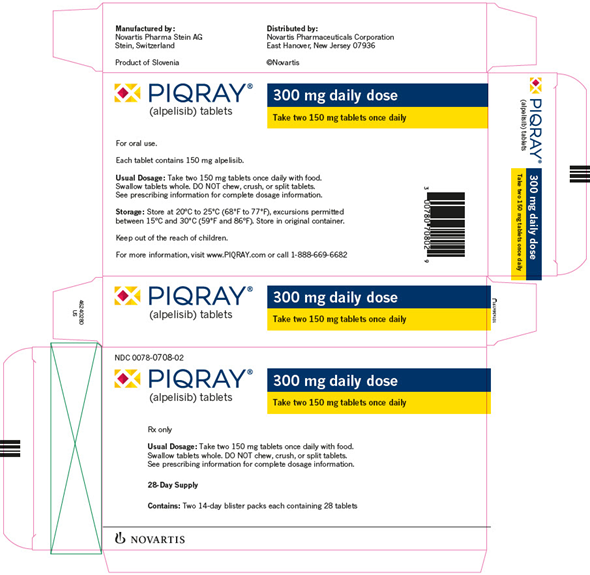
主要显示面板
NDC 0078-0715-02
PIQRAY ®
(alpelisib)片
每日250毫克
每天一次服用200毫克片剂和 50毫克片剂
仅Rx
通常剂量:每天一次 与食物一起服用200毫克片剂和 50毫克片剂
。吞咽片整个。请勿咀嚼,压碎或分裂药片。
有关完整的剂量信息,请参阅处方信息。28天供应
包含:两个14天吸塑包装,每个包含28片:
每包200毫克 14片
每包50毫克 14片新星
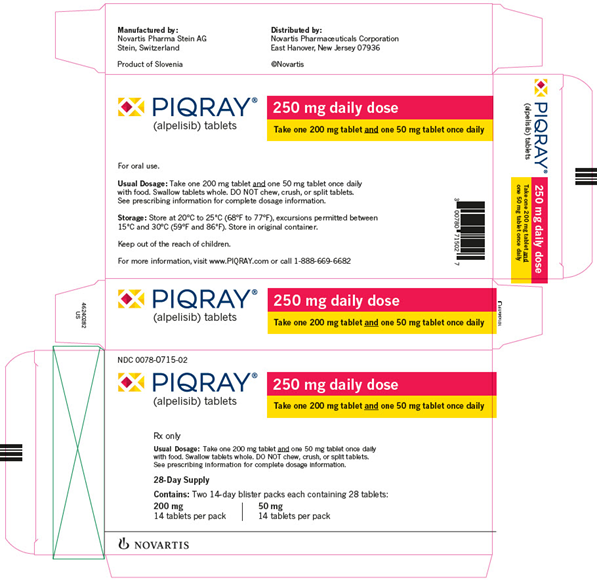
主要显示面板
NDC 0078-0701-84
PIQRAY ®
(alpelisib)片
每日200毫克
每天一次服用200毫克片剂
仅Rx
通常剂量:每天一次与食物一起服用200毫克片剂。
吞咽片整个。请勿咀嚼,压碎或分裂药片。
有关完整的剂量信息,请参阅处方信息。28天供应
包含:一个泡罩包装,包含28片
新星
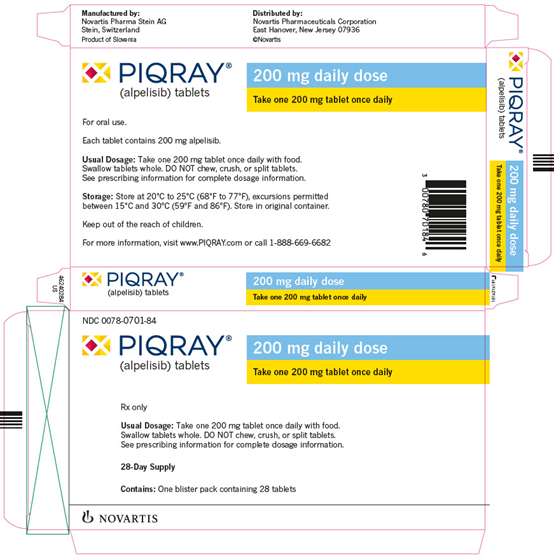
【备注】以上内容仅供参考,不作为用药依据,详情请参照药品附带说明书。
-
本说明书来源于:美国FDA
温馨提醒:
①建议您用 谷歌浏览器 在电脑上或手机 打开以上链接,就可以自动翻译成简体中文,而且翻译的还比较准确。
②本说明书仅供参考,最新的说明书详见药品附带的说明书。
FULL PRESCRIBING INFORMATION
1 INDICATIONS AND USAGE
PIQRAY is indicated in combination with fulvestrant for the treatment of postmenopausal women, and men, with hormone receptor (HR)-positive, human epidermal growth factor receptor 2 (HER2)-negative, PIK3CA-mutated, advanced or metastatic breast cancer as detected by an FDA-approved test following progression on or after an endocrine-based regimen.
2 DOSAGE AND ADMINISTRATION
2.1 Patient Selection
Select patients for the treatment of HR-positive, HER2-negative advanced or metastatic breast cancer with PIQRAY, based on the presence of one or more PIK3CA mutations in tumor tissue or plasma specimens [see Clinical Studies (14)]. If no mutation is detected in a plasma specimen, test tumor tissue. Information on FDA-approved tests for the detection of PIK3CA mutations in breast cancer is available at: http://www.fda.gov/CompanionDiagnostics.
2.2 Dosage and Administration
The recommended dose of PIQRAY is 300 mg (two 150 mg film-coated tablets) taken orally, once daily, with food [see Clinical Pharmacology (12.3)].
Continue treatment until disease progression or unacceptable toxicity occurs [see Dosage and Administration (2.3)].
Patients should take their dose of PIQRAY at approximately the same time each day.
Swallow PIQRAY tablets whole (tablets should not be chewed, crushed or split prior to swallowing). No tablet should be ingested if it is broken, cracked, or otherwise not intact.
If a dose of PIQRAY is missed, it can be taken with food within 9 hours after the time it is usually taken. After more than 9 hours, skip the dose for that day. The next day, take PIQRAY at the usual time.
If the patient vomits after taking the dose, advise the patient not to take an additional dose on that day, and to resume the dosing schedule the next day at the usual time.
When given with PIQRAY, the recommended dose of fulvestrant is 500 mg administered on Days 1, 15, and 29, and once monthly thereafter. Refer to the Full Prescribing Information for fulvestrant.
2.3 Dose Modifications for Adverse Reactions
The recommended dose modifications for adverse reactions (ARs) are listed in Table 1.
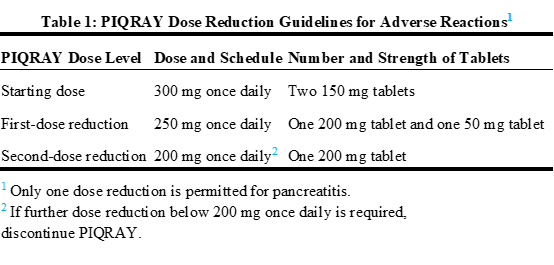
Tables 2, 3, 4, and 5 summarize recommendations for dose interruption, reduction, or discontinuation of PIQRAY in the management of specific ARs.
Hyperglycemia
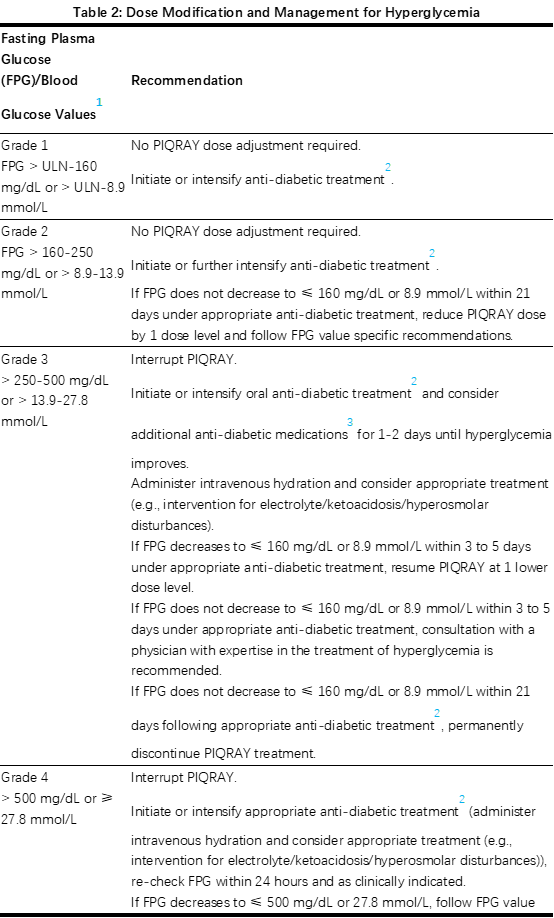
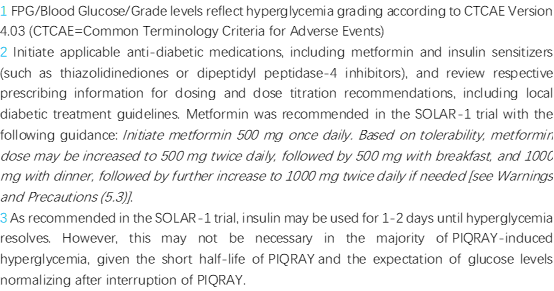
Rash
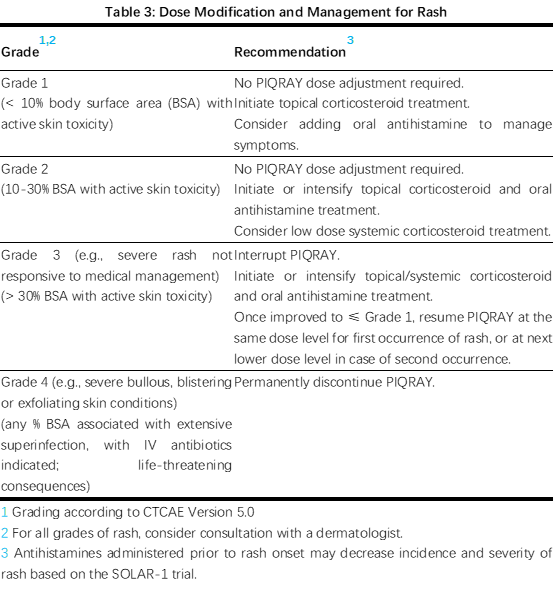
Diarrhea
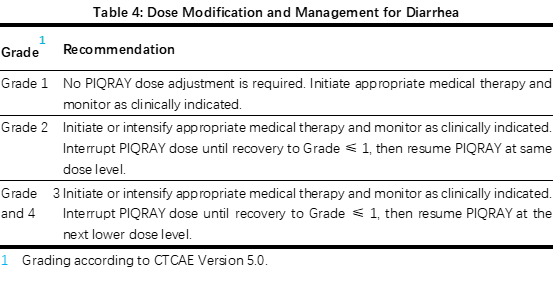
Other Toxicities
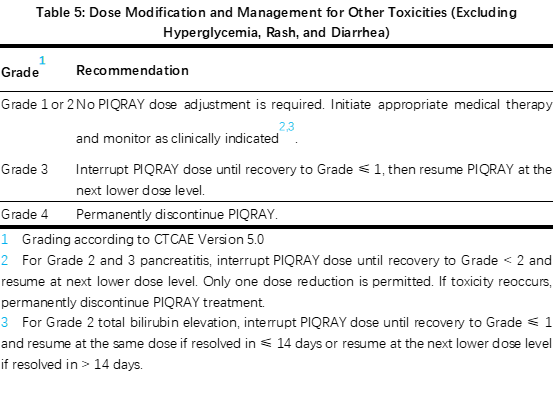
Refer to the Full Prescribing Information of fulvestrant for dose modification guidelines in the event of toxicity and for other relevant safety information.
3 DOSAGE FORMS AND STRENGTHS
Tablets: 50 mg, 150 mg, and 200 mg alpelisib
50 mg: Light pink, unscored, round and curved with beveled edges film-coated tablet, imprinted with “L7” on one side and “NVR” on the other side.
150 mg: Pale red, unscored, ovaloid and curved with beveled edges film-coated tablet, imprinted with “UL7” on one side and “NVR” on the other side.
200 mg: Light red, unscored, ovaloid and curved with beveled edges film-coated tablet, imprinted with “YL7” on one side and “NVR” on the other side.
4 CONTRAINDICATIONS
PIQRAY is contraindicated in patients with severe hypersensitivity to it or any of its components [see Warnings and Precautions (5.1)].
5 WARNINGS AND PRECAUTIONS
5.1 Severe Hypersensitivity
Severe hypersensitivity reactions, including anaphylaxis and anaphylactic shock, were reported in patients treated with PIQRAY. Severe hypersensitivity reactions were manifested by symptoms including, but not limited to, dyspnea, flushing, rash, fever, or tachycardia.
The incidence of Grade 3 and 4 hypersensitivity reactions was 0.7% [see Adverse Reactions (6)].
Advise patients of the signs and symptoms of severe hypersensitivity reactions. Permanently discontinue PIQRAY in the event of severe hypersensitivity.
5.2 Severe Cutaneous Reactions
Severe cutaneous reactions, including Stevens-Johnson Syndrome (SJS) and Erythema Multiforme (EM) were reported in patients treated with PIQRAY [see Adverse Reactions (6)].
SJS and EM were reported in 0.4% and 1.1% of patients, respectively. Do not initiate PIQRAY treatment in patients with a history of SJS, EM, or Toxic Epidermal Necrolysis (TEN).
If signs or symptoms of severe cutaneous reactions occur, interrupt PIQRAY until the etiology of the reaction has been determined. Consultation with a dermatologist is recommended.
If SJS, TEN, or EM is confirmed, permanently discontinue PIQRAY. Do not reintroduce PIQRAY in patients who have experienced previous severe cutaneous reactions during PIQRAY treatment.
If SJS, TEN, or EM is not confirmed, PIQRAY may require dose modifications, topical corticosteroids, or oral antihistamine treatment as described in Table 3 [see Dosage and Administration (2.3)].
Advise patients of the signs and symptoms of severe cutaneous reactions (e.g., a prodrome of fever, flu-like symptoms, mucosal lesions or progressive skin rash).
5.3 Hyperglycemia
Severe hyperglycemia, including ketoacidosis, has been reported in patients treated with PIQRAY. Hyperglycemia was reported in 65% of patients treated with PIQRAY. Grade 3 (FPG > 250-500 mg/dL) and Grade 4 (FPG > 500 mg/dL) hyperglycemia was reported in 33% and 3.9% of patients, respectively. Ketoacidosis was reported in 0.7% of patients (n = 2) treated with PIQRAY.
Among the patients who experienced Grade ≥ 2 (FPG 160-250 mg/dL) hyperglycemia, the median time to first occurrence of hyperglycemia was 15 days (range: 5 to 517 days).
In the 187 patients with hyperglycemia, 87% (163/187) were managed with anti-diabetic medication, and 76% (142/187) reported use of metformin as single agent or in combination with other anti-diabetic medication [i.e., insulin, dipeptidyl peptidase-4 (DPP-4) inhibitors, and sulfonylureas]. In patients with Grade ≥ 2 hyperglycemia with at least 1 grade improvement (n = 153), median time to improvement from the first event was 8 days (range: 2 to 65 days).
In all patients with elevated FPG who continued fulvestrant treatment after discontinuing PIQRAY (n = 54), 96% (n = 52) of patients had FPG levels that returned to baseline.
Before initiating treatment with PIQRAY, test FPG, HbA1c, and optimize blood glucose. After initiating treatment with PIQRAY, monitor blood glucose and/or FPG at least once every week for the first 2 weeks, then at least once every 4 weeks, and as clinically indicated. Monitor HbA1c every 3 months and as clinically indicated.
If a patient experiences hyperglycemia after initiating treatment with PIQRAY, monitor blood glucose and/or FPG as clinically indicated, and at least twice weekly until blood glucose or FPG decreases to normal levels. During treatment with anti-diabetic medication, continue monitoring blood glucose or FPG at least once a week for 8 weeks, followed by once every 2 weeks and as clinically indicated. Consider consultation with a healthcare practitioner with expertise in the treatment of hyperglycemia and counsel patients on lifestyle changes.
The safety of PIQRAY in patients with Type 1 and uncontrolled Type 2 diabetes has not been established as these patients were excluded from the SOLAR-1 trial. Patients with a medical history of Type 2 diabetes were included. Patients with a history of diabetes mellitus may require intensified diabetic treatment. Closely monitor patients with diabetes.
Based on the severity of the hyperglycemia, PIQRAY may require dose interruption, reduction, or discontinuation as described in Table 2 [see Dosage and Administration (2.3)].
Advise patients of the signs and symptoms of hyperglycemia (e.g., excessive thirst, urinating more often than usual or higher amount of urine than usual, or increased appetite with weight loss).
5.4 Pneumonitis
Severe pneumonitis, including acute interstitial pneumonitis and interstitial lung disease, has been reported in patients treated with PIQRAY.
Pneumonitis was reported in 1.8% of patients treated with PIQRAY.
In patients who have new or worsening respiratory symptoms or are suspected to have developed pneumonitis, interrupt PIQRAY immediately and evaluate the patient for pneumonitis. Consider a diagnosis of non-infectious pneumonitis in patients presenting with non-specific respiratory signs and symptoms such as hypoxia, cough, dyspnea, or interstitial infiltrates on radiologic exams and in whom infectious, neoplastic, and other causes have been excluded by means of appropriate investigations.
Permanently discontinue PIQRAY in all patients with confirmed pneumonitis.
Advise patients to immediately report new or worsening respiratory symptoms.
5.5 Diarrhea
Severe diarrhea, including dehydration and acute kidney injury, occurred in patients treated with PIQRAY. Most patients (58%) experienced diarrhea during treatment with PIQRAY. Grade 3 diarrhea occurred in 7% (n = 19) of patients. Among patients with Grade 2 or 3 diarrhea (n = 71), the median time to onset was 46 days (range: 1 to 442 days).
Dose reductions of PIQRAY were required in 6% of patients and 2.8% of patients permanently discontinued PIQRAY due to diarrhea. In the 164 patients that experienced diarrhea, anti-diarrheal medications (e.g., loperamide) were required to manage symptoms in 63% (104/164) of these patients.
Based on the severity of the diarrhea, PIQRAY may require dose interruption, reduction, or discontinuation as described in Table 4 [see Dosage and Administration (2.3)].
Advise patients to start antidiarrheal treatment, increase oral fluids, and notify their healthcare provider if diarrhea occurs while taking PIQRAY.
5.6 Embryo-Fetal Toxicity
Based on findings in animals and its mechanism of action, PIQRAY can cause fetal harm when administered to a pregnant woman. In animal reproduction studies, oral administration of alpelisib to pregnant rats and rabbits during organogenesis caused adverse developmental outcomes including embryo-fetal mortality (post-implantation loss), reduced fetal weights, and increased incidences of fetal malformations at maternal exposures based on area under the curve (AUC) that were ≥ 0.8 times the exposure in humans at the recommended dose of 300 mg/day. Advise pregnant women and females of reproductive potential of the potential risk to a fetus. Advise females of reproductive potential to use effective contraception during treatment with PIQRAY and for 1 week after the last dose. Advise male patients with female partners of reproductive potential to use condoms and effective contraception during treatment with PIQRAY and for 1 week after the last dose [see Use in Specific Populations (8.1, 8.3) and Clinical Pharmacology (12.1)].
Refer to the Full Prescribing Information of fulvestrant for pregnancy and contraception information.
6 ADVERSE REACTIONS
The following adverse reactions are discussed in greater detail in other sections of the labeling:
- Severe Hypersensitivity [see Warnings and Precautions (5.1)]
- Severe Cutaneous Reactions [see Warnings and Precautions (5.2)]
- Hyperglycemia [see Warnings and Precautions (5.3)]
- Pneumonitis [see Warnings and Precautions (5.4)]
- Diarrhea [see Warnings and Precautions (5.5)]
6.1 Clinical Trial Experience
Because clinical trials are conducted under widely varying conditions, adverse reaction rates observed in the clinical trials of a drug cannot be directly compared to rates in the clinical trials of another drug and may not reflect the rates observed in practice.
The safety of PIQRAY was evaluated in a randomized, double-blind, placebo-controlled trial (SOLAR-1) in 571 patients with HR-positive, HER2-negative, advanced or metastatic breast cancer enrolled into two cohorts, with or without a PIK3CA mutation [see Clinical Studies (14)].
Patients received either PIQRAY 300 mg plus fulvestrant (n = 284) or placebo plus fulvestrant (n = 287). Fulvestrant 500 mg was administered intramuscularly on Cycle 1, Day 1 and 15 and then at Day 1 of each 28-day cycle during treatment phase.
Two patients (0.7%) died while on treatment with PIQRAY plus fulvestrant due to causes other than the underlying malignancy. Causes of death included one cardio-respiratory arrest and one second primary malignancy. Neither was suspected to be related to study treatment.
Serious adverse reactions occurred in 35% of patients receiving PIQRAY plus fulvestrant. Serious adverse reactions in > 2% of patients receiving PIQRAY plus fulvestrant included hyperglycemia (10%), rash (3.5%), diarrhea (2.8%), acute kidney injury (2.5%), abdominal pain (2.1%), and anemia (2.1%).
Osteonecrosis of the jaw (ONJ) was reported in 4.2% of patients (12/284) in the PIQRAY plus fulvestrant arm compared to 1.4% of patients (4/287) in the placebo arm. All patients experiencing ONJ had prior or concomitant bisphosphonates or RANK-ligand inhibitor administration.
Among patients receiving PIQRAY plus fulvestrant, 4.6% permanently discontinued both PIQRAY and fulvestrant and 21% permanently discontinued PIQRAY alone, due to ARs. The most frequent ARs leading to treatment discontinuation of PIQRAY in > 2% patients receiving PIQRAY plus fulvestrant were hyperglycemia (6%), rash (4.2%), diarrhea (2.8%), and fatigue (2.5%).
Dose reductions due to ARs occurred in 55% of patients receiving PIQRAY plus fulvestrant. The most frequent ARs leading to dose reduction in > 2% patients receiving PIQRAY plus fulvestrant were hyperglycemia (29%), rash (9%), diarrhea (6%), stomatitis (3.5%) and mucosal inflammation (2.1%).
The most common adverse reactions including laboratory abnormalities (all grades, incidence ≥ 20%) were glucose increased, creatinine increased, diarrhea, rash, lymphocyte count decreased, GGT increased, nausea, ALT increased, fatigue, hemoglobin decreased, lipase increased, decreased appetite, stomatitis, vomiting, weight decreased, calcium decreased, glucose decreased, aPTT prolonged, and alopecia.
Adverse reactions and laboratory abnormalities are listed in Table 6 and Table 7, respectively.
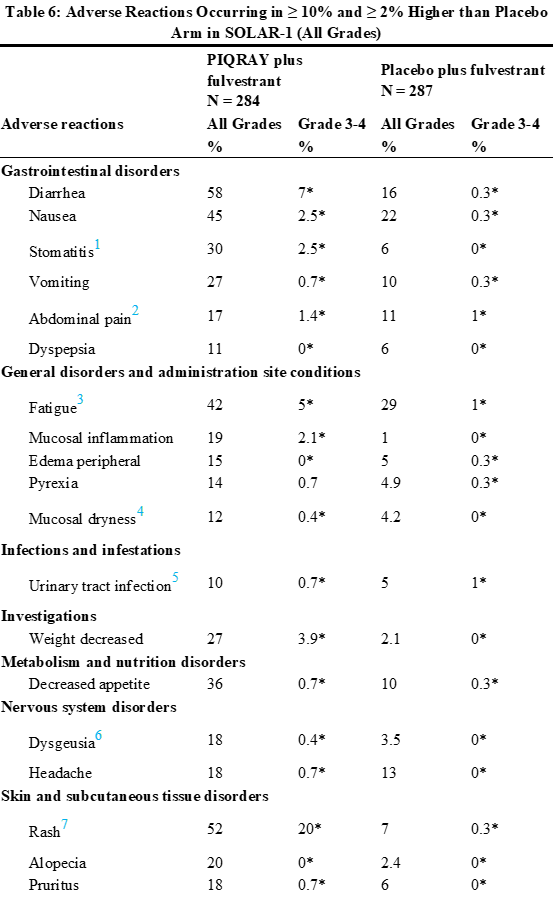
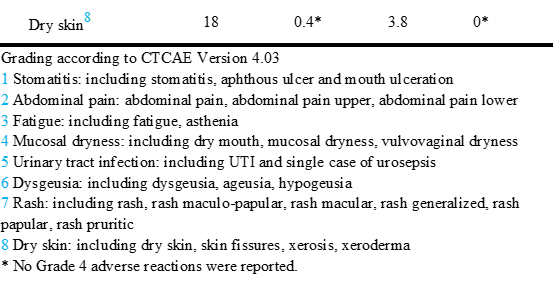
Among the patients with Grade 2 or 3 rash, the median time to first onset of Grade 2 or 3 rash was 12 days. A subgroup of 86 patients received prophylaxis, including anti-histamines, prior to onset of rash. In these patients, rash was reported less frequently than in the overall population, for all grades rash (27% vs 54%), Grade 3 rash (12% vs 20%) and rash leading to permanent discontinuation of PIQRAY (3.5% vs 4.2%). Of the 153 patients who experienced rash, 141 had resolution of the rash.
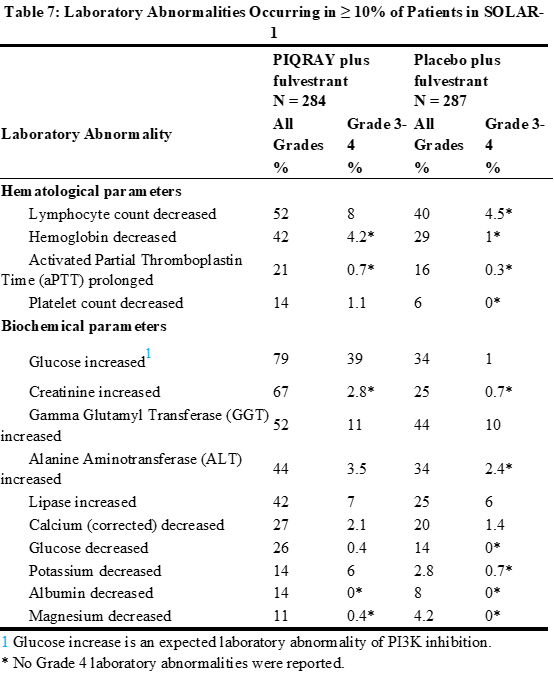
7 DRUG INTERACTIONS
7.1 Effect of Other Drugs on PIQRAY
CYP3A4 Inducer
Coadministration of PIQRAY with a strong CYP3A4 inducer may decrease alpelisib concentration [see Clinical Pharmacology (12.3)], which may decrease alpelisib activity. Avoid coadministration of PIQRAY with strong CYP3A4 inducers.
BCRP Inhibitors
Coadministration of PIQRAY with a BCRP inhibitor may increase alpelisib concentration [see Clinical Pharmacology (12.3)], which may increase the risk of toxicities. Avoid the use of BCRP inhibitors in patients treated with PIQRAY. If unable to use alternative drugs, when PIQRAY is used in combination with BCRP inhibitors, closely monitor for increased adverse reactions.
7.2 Effect of PIQRAY on Other Drugs
CYP2C9 Substrates
Coadministration of PIQRAY with CYP2C9 substrates (e.g., warfarin) may reduce plasma concentration of these drugs [see Clinical Pharmacology (12.3)]. Closely monitor when PIQRAY is used in combination with CYP2C9 substrates where decreases in the plasma concentration of CYP2C9 substrates may reduce activity of these drugs.
8 USE IN SPECIFIC POPULATIONS
8.1 Pregnancy
Risk Summary
PIQRAY is used in combination with fulvestrant. Refer to the Full Prescribing Information of fulvestrant for pregnancy information.
Based on animal data and mechanism of action, PIQRAY can cause fetal harm when administered to a pregnant woman [see Clinical Pharmacology (12.1)]. There are no available data in pregnant women to inform the drug-associated risk. In animal reproduction studies, oral administration of alpelisib to pregnant rats and rabbits during organogenesis caused adverse developmental outcomes including embryo-fetal mortality (post-implantation loss), reduced fetal weights, and increased incidences of fetal malformations at maternal exposures ≥ 0.8 times the exposure in humans based on AUC at the recommended dose of 300 mg/day (see Data). Advise pregnant women and females of reproductive potential of the potential risk to a fetus.
The estimated background risk of major birth defects and miscarriage for the indicated population is unknown. However, the estimated background risk of major birth defects is 2% to 4% and of miscarriage is 15% to 20% of clinically recognized pregnancies in the U.S. general population.
Data
Animal Data
In embryo-fetal development studies in rats and rabbits, pregnant animals received oral doses of alpelisib up to 30 mg/kg/day during the period of organogenesis.
In rats, oral administration of alpelisib resulted in maternal toxicity (body weight loss, low food consumption) and no viable fetuses (post-implantation loss) at 30 mg/kg/day (approximately 3 times the exposure in humans at the recommended dose of 300 mg/day based on AUC). At a dose of 10 mg/kg/day (approximately 0.8 times the exposure in humans at the recommended dose of 300 mg/day based on AUC), toxicities included reduced fetal weight and increased incidences of skeletal malformations (bent scapula and thickened or bent long bones) and fetal variations (enlarged brain ventricle, decreased bone ossification).
In a pilot embryo-fetal development study in rabbits, a dose of 30 mg/kg/day resulted in no viable fetuses (post-implantation loss). Doses ≥ 15 mg/kg/day resulted in increased embryo-fetal deaths, reduced fetal weights, and malformations, mostly related to the tail and head. At 15 mg/kg/day in rabbits, the maternal exposure was approximately 5 times the exposure achieved at the recommended human dose of 300 mg/day based on AUC.
8.2 Lactation
PIQRAY is used in combination with fulvestrant. Refer to the Full Prescribing Information of fulvestrant for lactation information.
There is no data on the presence of alpelisib in human milk, its effects on milk production, or the breastfed child. Because of the potential for serious adverse reactions in the breastfed child, advise lactating women to not breastfeed during treatment with PIQRAY and for 1 week after the last dose.
8.3 Females and Males of Reproductive Potential
PIQRAY is used in combination with fulvestrant. Refer to the Full Prescribing Information of fulvestrant for contraception and infertility information.
Pregnancy Testing
Verify the pregnancy status in females of reproductive potential prior to initiating PIQRAY.
Contraception
Females
PIQRAY can cause fetal harm when administered to a pregnant woman [see Use in Specific Populations (8.1)]. Advise females of reproductive potential to use effective contraception during treatment with PIQRAY and for 1 week after the last dose.
Males
Advise male patients with female partners of reproductive potential to use condoms and effective contraception during treatment with PIQRAY and for 1 week after the last dose.
Infertility
Based on findings from animal studies, PIQRAY may impair fertility in males and females of reproductive potential [see Nonclinical Toxicology (13.1)].
8.4 Pediatric Use
The safety and efficacy of PIQRAY in pediatric patients have not been established.
8.5 Geriatric Use
Of 284 patients who received PIQRAY in the SOLAR-1 trial, 117 patients were ≥ 65 years of age and 34 patients were ≥ 75 years of age. In patients treated with PIQRAY plus fulvestrant, there was a higher incidence of Grade 3-4 hyperglycemia in patients ≥ 65 years of age (44%) compared to patients < 65 years of age (32%). No overall differences in effectiveness of PIQRAY were observed between patients ≥ 65 years of age compared to younger patients. There are an insufficient number of patients ≥ 75 years of age to assess whether there are differences in safety or effectiveness.
8.6 Renal Impairment
The effect of severe renal impairment (CLcr < 30 mL/min) on alpelisib pharmacokinetics is unknown [see Clinical Pharmacology (12.3)].
No dose adjustment is recommended for patients with mild to moderate renal impairment (CLcr 30 to < 90 mL/min).
10 OVERDOSAGE
There is limited experience of overdose with PIQRAY in clinical trials. In the clinical studies, PIQRAY was administered at doses up to 450 mg once daily.
In cases where accidental overdosage of PIQRAY was reported in the clinical studies, the adverse reactions associated with the overdose were consistent with the known safety profile of PIQRAY and included hyperglycemia, nausea, asthenia, and rash.
Initiate general symptomatic and supportive measures in all cases of overdosage where necessary. There is no known antidote for PIQRAY.
11 DESCRIPTION
PIQRAY (alpelisib) is a kinase inhibitor. The chemical name of alpelisib is (2S)-N1-[4-Methyl-5-[2-(2,2,2-trifluoro-1,1-dimethylethyl)-4-pyridinyl]-2-thiazolyl]-1,2-pyrrolidinedicarboxamide. Alpelisib is a white to almost white powder. The molecular formula for alpelisib is C19H22F3N5O2S and the relative molecular mass is 441.47 g/mol. The chemical structure of alpelisib is shown below:
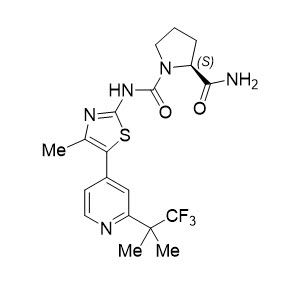
PIQRAY film-coated tablets are supplied for oral administration with three strengths that contain 50 mg, 150 mg and 200 mg of alpelisib. The tablets also contain hypromellose, magnesium stearate, mannitol, microcrystalline cellulose, and sodium starch glycolate. The film-coating contains hypromellose, iron oxide black, iron oxide red, macrogol/polyethylene glycol (PEG) 4000, talc, and titanium dioxide.
12 CLINICAL PHARMACOLOGY
12.1 Mechanism of Action
Alpelisib is an inhibitor of phosphatidylinositol-3-kinase (PI3K) with inhibitory activity predominantly against PI3Kα. Gain-of-function mutations in the gene encoding the catalytic α-subunit of PI3K (PIK3CA) lead to activation of PI3Kα and Akt-signaling, cellular transformation and the generation of tumors in in vitro and in vivo models.
In breast cancer cell lines, alpelisib inhibited the phosphorylation of PI3K downstream targets, including Akt and showed activity in cell lines harboring a PIK3CA mutation. In vivo, alpelisib inhibited the PI3K/Akt signaling pathway and reduced tumor growth in xenograft models, including models of breast cancer.
PI3K inhibition by alpelisib treatment has been shown to induce an increase in estrogen receptor (ER) transcription in breast cancer cells. The combination of alpelisib and fulvestrant demonstrated increased anti-tumor activity compared to either treatment alone in xenograft models derived from ER-positive, PIK3CA mutated breast cancer cell lines.
12.2 Pharmacodynamics
Cardiac Electrophysiology
Serial ECGs were collected following a single dose and at steady-state to evaluate the effect of alpelisib on the QTcF interval in patients with advanced cancer. An analysis of clinical ECG data demonstrates the absence of a large effect (i.e., > 20 ms) on QTcF prolongation at the recommended 300 mg dose with or without fulvestrant.
12.3 Pharmacokinetics
The pharmacokinetics of alpelisib has been studied in healthy subjects and adult patients with solid tumors. Steady-state alpelisib maximum plasma concentration (Cmax) and AUC increased proportionally over the dose range of 30 mg to 450 mg (0.1 to 1.5 times the approved recommended dosage) under fed conditions. The mean accumulation of alpelisib is 1.3 to 1.5 and steady-state plasma concentrations are reached within 3 days following daily dosage. In adult patients who received PIQRAY 300 mg once daily in the SOLAR-1 trial, population approach derived mean steady-state alpelisib [coefficient of variation (CV%)] for Cmax was 2480 (23%) ng/mL and AUC0-24hr was 33224 (21%) ng*h/mL.
Absorption
The median time to reach peak plasma concentration (Tmax) ranged between 2.0 to 4.0 hours.
Effect of food
A high-fat high-calorie meal (985 calories with 58.1 g of fat) increased alpelisib AUC by 73% and Cmax by 84%, and a low-fat low-calorie meal (334 calories with 8.7 g of fat) increased alpelisib AUC by 77% and Cmax by 145% following a single dose of PIQRAY. No clinically significant differences in alpelisib AUC were observed between low-fat low-calorie and high-fat high-calorie meals.
Distribution
The mean (% CV) apparent volume of distribution of alpelisib at steady-state is predicted to be 114 L (46%). Protein binding of alpelisib is 89% and is independent of concentration.
Elimination
The half-life of alpelisib is predicted to be 8 to 9 hours. The mean (% CV) clearance of alpelisib is predicted to be 9.2 L/hr (21%) under fed conditions.
Metabolism
Alpelisib is primarily metabolized by chemical and enzymatic hydrolysis to form its metabolite BZG791 and to a lesser extent by CYP3A4, in vitro.
Excretion
Following a single oral dose of 400 mg radiolabeled alpelisib under fasted condition, 81% of the administered dose was recovered in feces (36% unchanged, 32% BZG791) and 14% (2% unchanged, 7.1% BZG791) in urine. CYP3A4-mediated metabolites (12%) and glucuronides amounted to approximately 15% of the dose.
Specific Populations
No clinically significant differences in the pharmacokinetics of alpelisib were predicted based on age (21 to 87 years), sex, race/ethnicity (Japanese or Caucasian), body weight (37 to 181 kg), mild to moderate renal impairment (CLcr 30 to < 90 mL/min based on the Cockcroft-Gault formula), or mild to severe hepatic impairment (Child-Pugh Class A, B, and C). The effect of severe renal impairment (CLcr < 30 mL/min) on the pharmacokinetics of alpelisib is unknown.
Drug Interaction Studies
Clinical Studies
Acid Reducing Agents: PIQRAY can be coadministered with acid reducing agents, since PIQRAY should be taken with food. Food exhibited a more pronounced effect on the solubility of alpelisib than the effect of gastric pH value.
Coadministration of the H2 receptor antagonist ranitidine in combination with a single 300 mg oral dose of alpelisib decreased the absorption and overall exposure of alpelisib. In the presence of a low-fat low-calorie meal, AUC was decreased on average by 21% and Cmax by 36% with ranitidine. Under the fasted state, AUC was decreased on average by 30% and Cmax by 51% with ranitidine.
CYP3A4 Substrates: No clinically significant differences in pharmacokinetics of everolimus (a substrate of CYP3A4 and P-gp) were observed when coadministered with alpelisib.
In Vitro Studies
Effect of Alpelisib on CYP Enzymes: Alpelisib inhibits CYP3A4 in a time-dependent manner and induces CYP2B6, CYP2C9 and CYP3A4.
Effect of Transporter on Alpelisib: Alpelisib is a substrate of BCRP.
Effect of Alpelisib on Transporters: Alpelisib is an inhibitor of P-gp. Alpelisib has a low potential to inhibit BCRP, MRP2, BSEP, OATP1B1, OATP1B3, OCT1, OAT1, OAT3, OCT2, MATE1, and MATE2K at clinically relevant concentrations.
13 NONCLINICAL TOXICOLOGY
13.1 Carcinogenesis, Mutagenesis, Impairment of Fertility
Carcinogenicity studies have not been conducted with alpelisib.
Alpelisib was not mutagenic in an in vitro bacterial reverse mutation (Ames) assay, or aneugenic or clastogenic in human cell micronucleus and chromosome aberration tests in vitro. Alpelisib was not genotoxic in an in vivo rat micronucleus test.
Fertility studies in animals have not been conducted. In repeated-dose toxicity studies up to 13 weeks duration, adverse effects were observed in reproductive organs including vaginal atrophy and estrous cycle variations in rats at doses ≥ 6 mg/kg/day (approximately 0.6 times the exposure in humans at the recommended dose of 300 mg/day based on AUC), and prostate atrophy in dogs at doses ≥ 15 mg/kg/day (approximately 2.6 times the exposure in humans at the recommended dose of 300 mg/day based on AUC).
14 CLINICAL STUDIES
SOLAR-1 (NCT02437318) was a randomized, double-blind, placebo-controlled trial of PIQRAY plus fulvestrant versus placebo plus fulvestrant in 572 patients with HR-positive, HER2-negative, advanced or metastatic breast cancer whose disease had progressed or recurred on or after an aromatase inhibitor-based treatment (with or without CDK4/6 combination). Patients were excluded if they had inflammatory breast cancer, diabetes mellitus Type 1 or uncontrolled Type 2, or pneumonitis. Randomization was stratified by presence of lung and/or liver metastasis and previous treatment with CDK4/6 inhibitor(s). Overall, 60% of enrolled patients had tumors with one or more PIK3CA mutations in tissue, 50% had liver/lung metastases, and 6% had previously been treated with a CDK4/6 inhibitor.
There were 341 patients enrolled by tumor tissue in the cohort with a PIK3CA mutation and 231 enrolled in the cohort without a PIK3CA mutation. Of the 341 patients in the cohort with a PIK3CA mutation, 336 (99%) patients had one or more PIK3CA mutations confirmed in tumor tissue using the FDA-approved therascreen® PIK3CA RGQ PCR Kit. Out of the 336 patients with PIK3CA mutations confirmed in tumor tissue, 19 patients had no plasma specimen available for testing with the FDA-approved therascreen® PIK3CA RGQ PCR Kit. Of the remaining 317 patients with PIK3CA mutations confirmed in tumor tissue, 177 patients (56%) had PIK3CA mutations identified in plasma specimen, and 140 patients (44%) did not have PIK3CA mutations identified in plasma specimen.
Patients received either PIQRAY (300 mg) or placebo orally once daily on a continuous basis, plus fulvestrant (500 mg) administered intramuscularly on Cycle 1, Days 1 and 15, and then on Day 1 of every 28-day cycle. Patients received treatment until radiographic disease progression or unacceptable toxicity. Tumor assessments were performed every 8 weeks for the first 18 months and every 12 weeks thereafter.
The median age of patients was 63 years (range 25 to 92). Most patients were women (99.8%) and most patients were White (66%), followed by Asian (22%), Other/Unknown (10%), Black or African American (1.4%), and American Indian or Alaskan Native (0.9%). Baseline ECOG performance status was 0 (68%) or 1 (32%).
Patient demographics for those with PIK3CA-mutated tumors were generally representative of the broader study population. The median duration of exposure to PIQRAY plus fulvestrant was 8.2 months with 59% of patients exposed for > 6 months.
The majority of patients (98%) received prior hormonal therapy as the last treatment (48% metastatic setting, 52% adjuvant setting). Primary endocrine resistance, defined as relapsed within 24 months on adjuvant endocrine therapy or progression within 6 months on endocrine therapy for advanced disease, was observed in 13% of patients and secondary endocrine resistance, defined as relapsed after 24 months on adjuvant endocrine therapy, relapsed within 12 months of the end of adjuvant endocrine therapy, or progression after 6 months on endocrine therapy for advanced disease, was observed in 72% of patients.
The major efficacy outcome was investigator-assessed progression-free survival (PFS) in the cohort with a PIK3CA mutation per Response Evaluation Criteria in Solid Tumors (RECIST) v1.1. Additional efficacy outcome measures were overall response rate (ORR) and overall survival (OS) in the cohort with a PIK3CA mutation.
Efficacy results for the cohort with a PIK3CA mutation in tumor tissue are presented in Table 8 and Figure 1. PFS results for the cohort with a PIK3CA mutation by investigator assessment were supported by consistent results from a blinded independent review committee (BIRC) assessment. Consistent results were seen in patients with tissue or plasma PIK3CA mutations. At the time of final PFS analysis, 27% (92/341) of patients had died, and overall survival follow-up was immature.
No PFS benefit was observed in patients whose tumors did not have a PIK3CA tissue mutation (HR = 0.85; 95% CI: 0.58, 1.25).
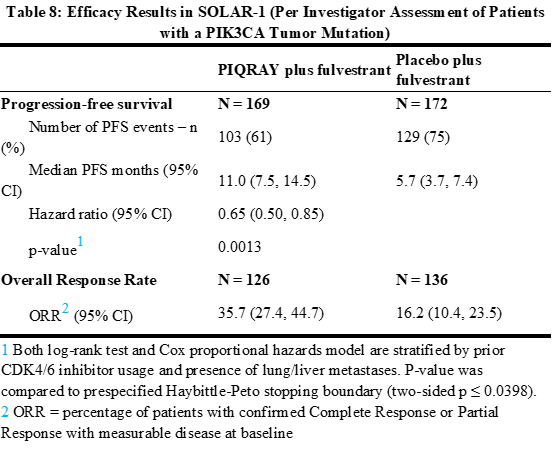
Figure 1: Progression Free Survival in SOLAR-1 (Per Investigator Assessment of Patients with a PIK3CA Tumor Mutation)
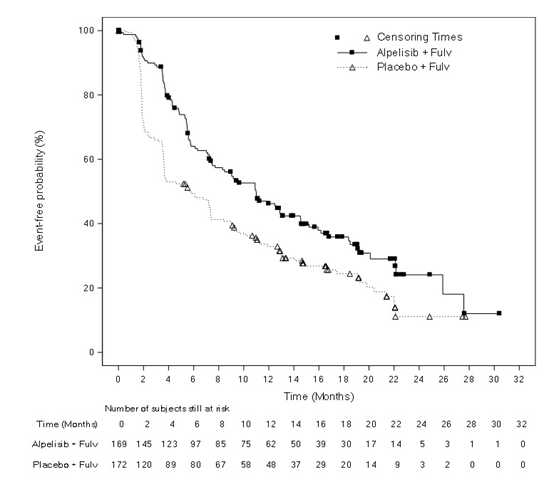
16 HOW SUPPLIED/STORAGE AND HANDLING
PIQRAY (alpelisib) 50 mg, 150 mg, and 200 mg film-coated tablets [see Dosage Forms and Strengths (3)].
300 mg daily dose: Each carton contains 2 blister packs. Each blister pack contains a 14-day supply of 28 tablets (28 tablets, 150 mg alpelisib per tablet). NDC 0078-0708-02
250 mg daily dose: Each carton contains 2 blister packs. Each blister pack contains a 14-day supply of 28 tablets (14 tablets, 200 mg alpelisib per tablet and 14 tablets, 50 mg alpelisib per tablet). NDC 0078-0715-02
200 mg daily dose: Each carton contains 1 blister pack. Each blister pack contains a 28-day supply of 28 tablets (28 tablets, 200 mg alpelisib per tablet). NDC 0078-0701-84
Store at 20°C to 25°C (68°F to 77°F), excursions permitted between 15°C and 30°C (59°F and 86°F) [see USP Controlled Room Temperature].
17 PATIENT COUNSELING INFORMATION
Advise the patient to read the FDA-approved patient labeling (Patient Information).
Severe Hypersensitivity
Inform patients of the signs and symptoms of hypersensitivity. Advise patients to contact their healthcare provider immediately for signs and symptoms of hypersensitivity [see Warnings and Precautions (5.1)].
Severe Cutaneous Reactions
Inform patients of the signs and symptoms of severe cutaneous reactions. Advise patients to contact their healthcare provider immediately for signs and symptoms of severe cutaneous reactions [see Warnings and Precautions (5.2)].
Hyperglycemia
Advise patients of the possibility of developing hyperglycemia and the need to monitor blood glucose periodically during therapy. Advise patients to contact their healthcare provider immediately for signs and symptoms of hyperglycemia [see Warnings and Precautions (5.3)].
Pneumonitis
Inform patients of the possibility of developing pneumonitis and to immediately contact their healthcare provider if they experience respiratory problems [see Warnings and Precautions (5.4)].
Diarrhea
Advise patients that PIQRAY may cause diarrhea, which may be severe in some cases. Inform patients to start antidiarrheal treatment, increase oral fluids, and notify their healthcare provider if diarrhea occurs while taking PIQRAY [see Warnings and Precautions (5.5)].
Embryo-Fetal Toxicity
- Inform pregnant women and females of reproductive potential of the potential risk to a fetus. Advise females to inform their healthcare provider of a known or suspected pregnancy [see Warnings and Precautions (5.6) and Use in Specific Populations (8.1)].
- Advise females of reproductive potential to use effective contraception during treatment with PIQRAY and for 1 week after the last dose [see Use in Specific Populations (8.3)].
- Advise male patients with female partners of reproductive potential to use condoms and effective contraception during treatment with PIQRAY and for 1 week after the last dose [see Use in Specific Populations (8.3)].
- Refer to the Full Prescribing Information of fulvestrant for pregnancy and contraception information.
Lactation
Advise women not to breastfeed during treatment with PIQRAY and for 1 week after the last dose [see Use in Specific Populations (8.2)]. Refer to the Full Prescribing Information of fulvestrant for lactation information.
Infertility
Advise males and females of reproductive potential that PIQRAY may impair fertility [see Use in Specific Populations (8.3)]. Refer to the Full Prescribing Information of fulvestrant for infertility information.
Drug Interactions
Advise patients to avoid the use of strong CYP3A4 inducers in patients treated with PIQRAY. Advise patients to avoid the use of BCRP inhibitors in patients treated with PIQRAY. If unable to use alternative drugs, closely monitor for increased adverse reactions. Advise patients that close monitoring may be required when PIQRAY is coadministered with CYP2C9 substrates where decreases in the plasma concentration of CYP2C9 substrates may reduce activity of these drugs [see Drug Interactions (7.1, 7.2)].
Dosing
- Instruct patients to take PIQRAY at approximately the same time each day and to swallow the tablet(s) whole (tablets should not be chewed, crushed, or split prior to swallowing) [see Dosage and Administration (2.2)].
- Advise patients to take PIQRAY with food [see Drug Interactions (7.4)].
- Instruct patients that if a dose of PIQRAY is missed, it can be taken with food within 9 hours after the time it is usually taken. After more than 9 hours, skip the dose for that day. The next day, take PIQRAY at the usual time. Instruct patients not to take 2 doses to make up for a missed dose.
- Instruct patients that if they vomit after taking the dose of PIQRAY, they should not take an additional dose on that day, and to resume the usual dosing schedule the next day at the usual time [see Dosage and Administration (2.2)].
Distributed by:
Novartis Pharmaceuticals Corporation
East Hanover, New Jersey 07936© Novartis
T2019-57
PATIENT INFORMATION
PIQRAY® (pik' raye)
(alpelisib)
tablets
What is PIQRAY?
PIQRAY is a prescription medicine used in combination with the medicine fulvestrant to treat women who have gone through menopause and men:- who have hormone receptor (HR)-positive, human epidermal growth factor receptor 2 (HER2)-negative advanced breast cancer or breast cancer that has spread to other parts of the body (metastatic), with an abnormal phosphatidylinositol-3-kinase catalytic subunit alpha (PIK3CA) gene, and
- whose disease has progressed on or after endocrine therapy.
Your healthcare provider will test your cancer for an abnormal “PIK3CA” gene to make sure that PIQRAY is right for you.
It is not known if PIQRAY is safe and effective in children.Do not take PIQRAY if you have had a severe allergic reaction to PIQRAY or are allergic to any of the ingredients in PIQRAY.
- See the end of this Patient Information leaflet for a complete list of the ingredients in PIQRAY.
- See “What are the possible side effects of PIQRAY?” for signs and symptoms of severe allergic reactions.
Before you take PIQRAY, tell your healthcare provider about all of your medical conditions, including if you:
- have a history of diabetes
- have a history of skin rash, redness of skin, blistering of the lips, eyes or mouth, or skin peeling
- are pregnant or plan to become pregnant. PIQRAY can harm your unborn baby.
Females who are able to become pregnant:
○ Your healthcare provider will check to see if you are pregnant before you start treatment with PIQRAY.
○ You should use effective birth control during treatment with PIQRAY and for 1 week after the last dose. Talk to your healthcare provider about birth control methods that may be right for you during this time.
○ If you become pregnant or think you are pregnant, tell your healthcare provider right away.
Males with female partners who are able to become pregnant should use condoms and effective birth control during treatment with PIQRAY and for 1 week after the last dose. If your female partner becomes pregnant, tell your healthcare provider right away.
You should also read the Full Prescribing Information of fulvestrant for important pregnancy, contraception, and infertility information.- are breastfeeding or plan to breastfeed. It is not known if PIQRAY passes into your breast milk. Do not breastfeed during treatment with PIQRAY and for 1 week after the last dose. You should also read the Full Prescribing Information of fulvestrant for important lactation information.
Tell your healthcare provider about all of the medicines you take, including prescription and over-the-counter medicines, vitamins, and herbal supplements. PIQRAY and other medicines may affect each other causing side effects. Know the medicines you take. Keep a list of them to show your healthcare provider or pharmacist when you get a new medicine.
How should I take PIQRAY?
- Take PIQRAY exactly as your healthcare provider tells you.
- Do not change your dose or stop taking PIQRAY unless your healthcare provider tells you.
- Take PIQRAY 1 time each day, at about the same time each day.
- Take PIQRAY with food.
- Swallow PIQRAY tablets whole. Do not chew, crush or split the tablets.
- Do not take any PIQRAY tablets that are broken, cracked, or that look damaged.
- If you miss a dose of PIQRAY, you may still take it with food up to 9 hours after the time you usually take it. If it has been more than 9 hours after you usually take your dose, skip the dose for that day. The next day, take the dose at your usual time. Do not take 2 doses to make up for a missed dose.
- If you vomit after taking a dose of PIQRAY, do not take another dose on that day. Take your next dose at your usual time.
- If you take too much PIQRAY, call your healthcare provider or go to the nearest hospital emergency room right away.
What are the possible side effects of PIQRAY?
PIQRAY may cause serious side effects, including:- Severe allergic reactions. Tell your healthcare provider or get medical help right away if you have trouble breathing, flushing, rash, fever, or fast heart rate during treatment with PIQRAY.
- Severe skin reactions. Tell your healthcare provider or get medical help right away if you get severe rash or rash that keeps getting worse, reddened skin, flu-like symptoms, blistering of the lips, eyes or mouth, blisters on the skin or skin peeling, with or without fever.
- High blood sugar levels (hyperglycemia). Hyperglycemia is common with PIQRAY and can be severe. Your healthcare provider will monitor your blood sugar levels before you start and during treatment with PIQRAY. Your healthcare provider may monitor your blood sugar levels more often if you have a history of Type 2 diabetes. Tell your healthcare provider right away if you develop symptoms of hyperglycemia, including:
◦ excessive thirst
◦ dry mouth
◦ more frequent urination than usual or a higher amount of urine than normal
◦ increased appetite with weight loss
- Lung problems (pneumonitis). Tell your healthcare provider right away if you develop new or worsening symptoms of lung problems, including:
◦ shortness of breath or trouble breathing
◦ cough
◦ chest pain
- Diarrhea. Diarrhea is common with PIQRAY and can be severe. Severe diarrhea can lead to the loss of too much body water (dehydration) and kidney problems. If you develop diarrhea during treatment with PIQRAY, tell your healthcare provider right away. Your healthcare provider may tell you to drink more fluids or take medicines to treat diarrhea.
Your healthcare provider may tell you to decrease your dose, temporarily stop your treatment, or completely stop your treatment with PIQRAY if you get certain serious side effects.
The most common side effects of PIQRAY when used with fulvestrant include:
- rash
- nausea
- tiredness and weakness
- decreased appetite
- mouth sores
- vomiting
- weight loss
- hair loss
- changes in certain blood tests
PIQRAY may affect fertility in males and in females who are able to become pregnant. Talk to your healthcare provider if this is a concern for you. These are not all of the possible side effects of PIQRAY.
Call your doctor for medical advice about side effects. You may report side effects to FDA at 1-800-FDA-1088.
How should I store PIQRAY?
Store PIQRAY at room temperature between 68°F to 77°F (20°C to 25°C).
Keep PIQRAY and all medicines out of the reach of children.General information about the safe and effective use of PIQRAY
Medicines are sometimes prescribed for purposes other than those listed in a Patient Information leaflet. Do not use PIQRAY for a condition for which it was not prescribed. Do not give PIQRAY to other people, even if they have the same symptoms you have. It may harm them. You can ask your healthcare provider or pharmacist for more information about PIQRAY that is written for health professionals.What are the ingredients in PIQRAY?
Active ingredient: alpelisib
Inactive ingredients: hypromellose, magnesium stearate, mannitol, microcrystalline cellulose, and sodium starch glycolate. The film-coating contains hypromellose, iron oxide black, iron oxide red, macrogol/polyethylene glycol (PEG) 4000, talc, and titanium dioxide.Distributed by: Novartis Pharmaceuticals Corporation, East Hanover, New Jersey 07936
© Novartis
T2019-58
For more information, go to www.PIQRAY.com or call 1-833-4-PIQRAY (1-833-474-7729).This Patient Information has been approved by the U.S. Food and Drug Administration.
Issued: May 2019
PRINCIPAL DISPLAY PANEL
NDC 0078-0708-02
PIQRAY®
(alpelisib) tablets
300 mg daily dose
Take two 150 mg tablets once daily
Rx only
Usual Dosage: Take two 150 mg tablets once daily with food.
Swallow tablets whole. DO NOT chew, crush, or split tablets.
See prescribing information for complete dosage information.28-Day Supply
Contains: Two 14-day blister packs each containing 28 tablets
NOVARTIS
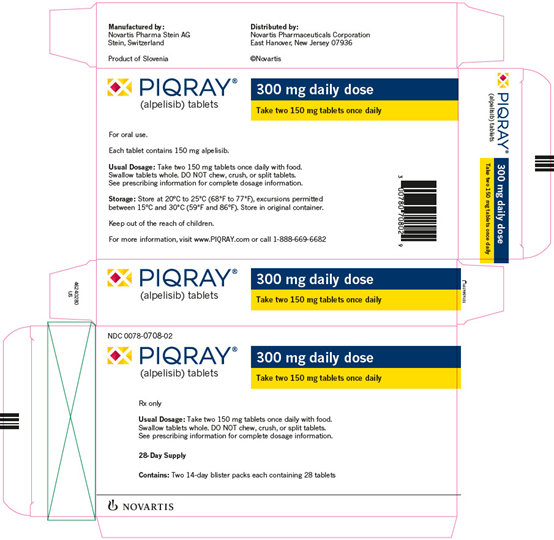
PRINCIPAL DISPLAY PANEL
NDC 0078-0715-02
PIQRAY®
(alpelisib) tablets
250 mg daily dose
Take one 200 mg tablet and one 50 mg tablet once daily
Rx only
Usual Dosage: Take one 200 mg tablet and one 50 mg tablet once daily
with food. Swallow tablets whole. DO NOT chew, crush, or split tablets.
See prescribing information for complete dosage information.28-Day Supply
Contains: Two 14-day blister packs each containing 28 tablets:
200 mg
14 tablets per pack50 mg
14 tablets per packNOVARTIS
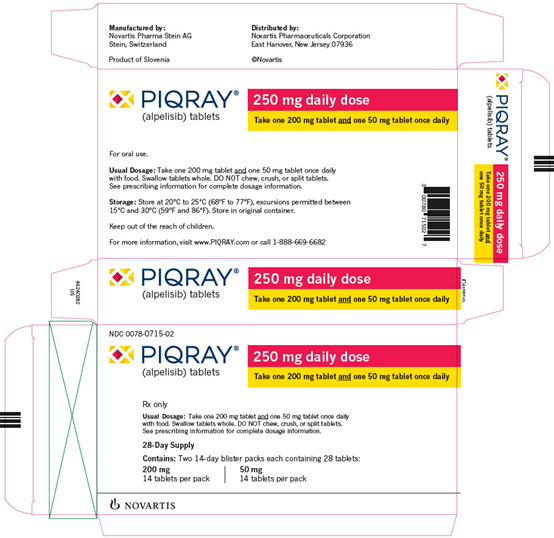
PRINCIPAL DISPLAY PANEL
NDC 0078-0701-84
PIQRAY®
(alpelisib) tablets
200 mg daily dose
Take one 200 mg tablet once daily
Rx only
Usual Dosage: Take one 200 mg tablet once daily with food.
Swallow tablets whole. DO NOT chew, crush, or split tablets.
See prescribing information for complete dosage information.28-Day Supply
Contains: One blister pack containing 28 tablets
NOVARTIS
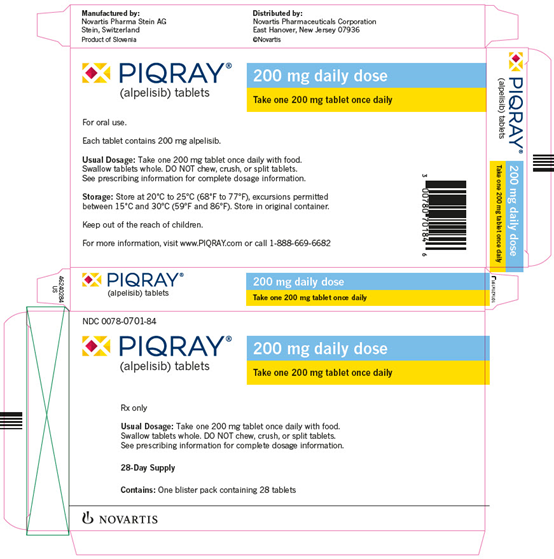
【备注】以上内容仅供参考,不作为用药依据,详情请参照药品附带说明书。
-
搜索更多相关资讯,请进入资讯页面








